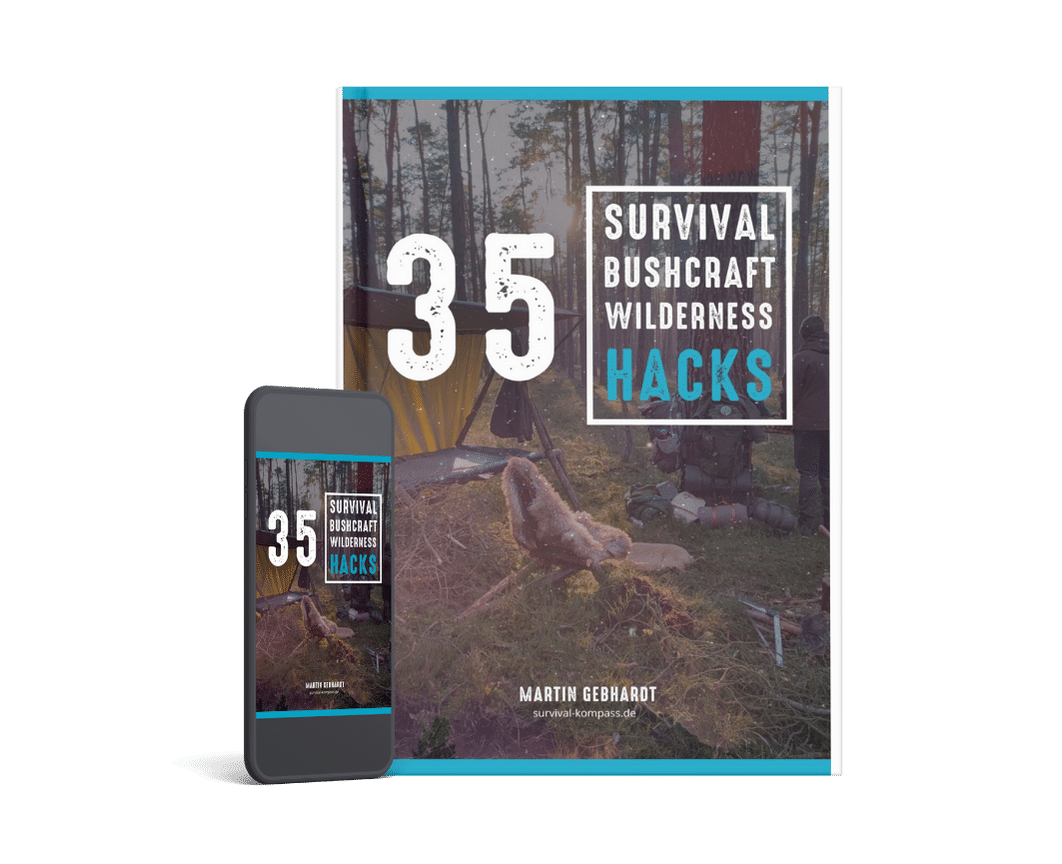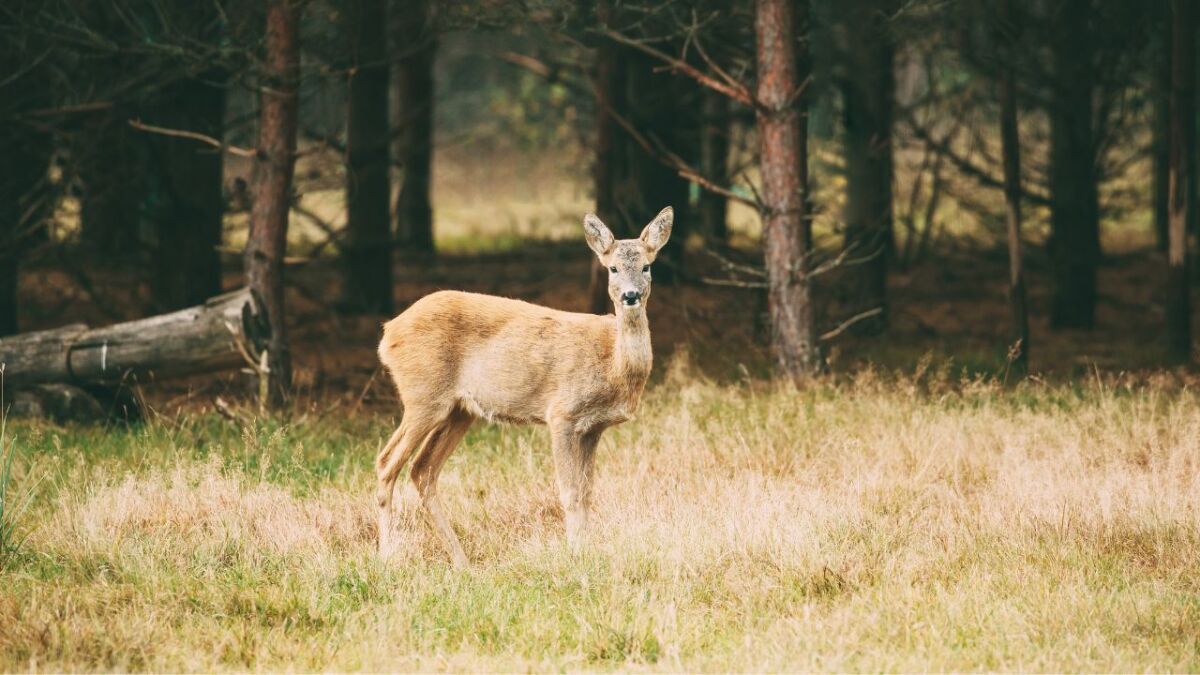
Ancestral knowledge: From fur to bone – Using the deer completely
👉 The key facts from this guide
- A deer is much more than just meat – it is a gift from nature that can be used completely: food, material, and tools in one.
- Meat and organs provide important nutrients – everything from the back to the lung is utilized, preserved, and prepared; nothing is wasted.
- Skin, fur, and hair are turned into clothing, bags, padding, or glue – whether as soft suede or stiff rawhide, every part has its purpose.
- Bones and antlers are transformed into tools, needles, fishing hooks, or jewelry – a whole toolbox directly from nature.
- Tendons, stomach, bladder, and even the brain serve for strings, containers, or as a component for tanning – absolutely nothing remains unused.
- This holistic use shows respect for life – a sustainable way back to the wisdom of our ancestors and a true learning for life.
A hunted deer – much more than just meat on the plate.
It is a gift from nature, a walking pharmacy, a complete toolbox.
Join me on a journey into the knowledge of our ancestors and discover how we can fully honor this gift with deep respect.
The Heritage of Ancestors: A Deer Fully Utilized with Respect
As a wilderness educator, I see it as my task not only to teach skills but also to convey an attitude: an attitude of gratitude, reverence, and deep connection with nature.
When we use an animal like the deer, we bear a responsibility that goes far beyond mere hunting.
Our ancestors knew that the life of an animal is most honored when everything from it is used – foremost as life-giving food.

This holistic use is not only the epitome of sustainability, it is a way to connect us with the cycles of life and the rich experiences of those who inhabited this land long before us.
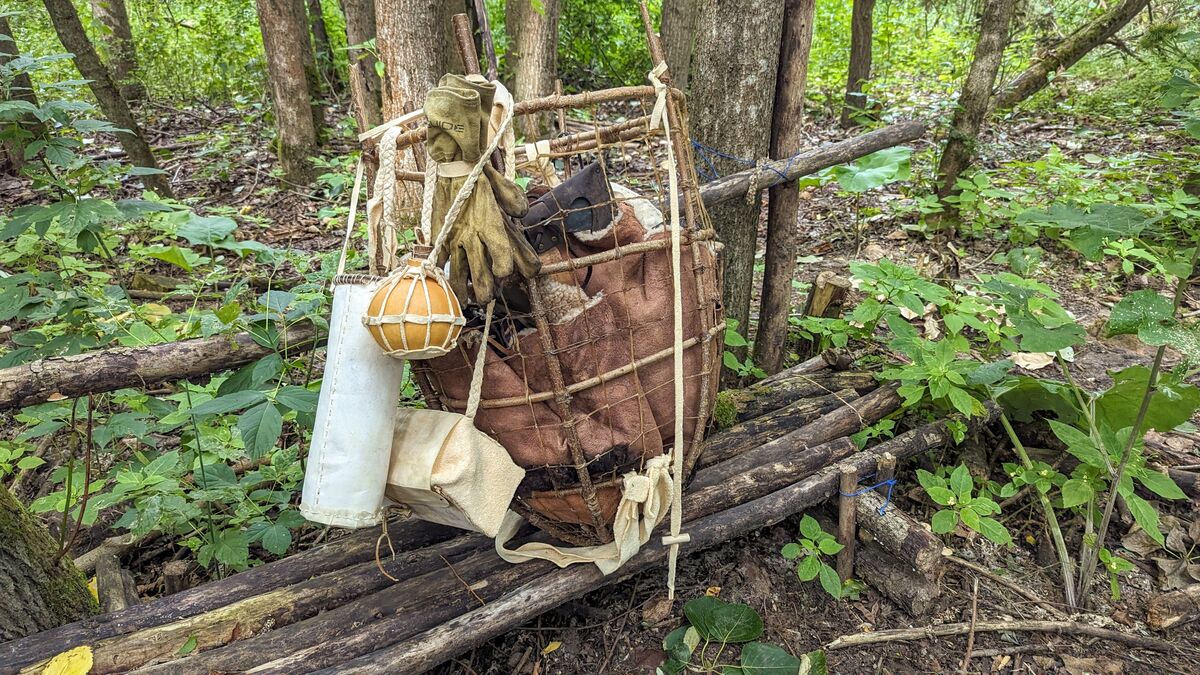
It is an act of respect that leaves no room for waste and teaches us to recognize the true value in every detail.
Let's dive in now and learn how to utilize a deer completely.
Food from the Inside and Outside: Meat and Edible Organs
The primary use of a hunted deer was and often is the acquisition of food. The philosophy of holistic utilization begins here: No edible part should go unused.
The Meat – The Main Source of Nutrition
The muscle meat is the most obvious and largest food component. Our ancestors knew the different parts and their optimal use:
- Noble cuts: Back and legs were often prepared fresh (roasted, boiled) or saved for special occasions.
- Shoulder, neck, belly flap: These cuts are excellent for braised dishes, stews, or were processed into sausage or ground meat (if the options were available).
- Sections and smaller pieces: Nothing was wasted. Smaller meat scraps were used for soups, stews, or for drying.
- Preservation: To preserve the meat, drying (jerky) and smoking were essential techniques. In colder regions, freezing in ice or snow was also added. Curing with salt was another method when salt was available.
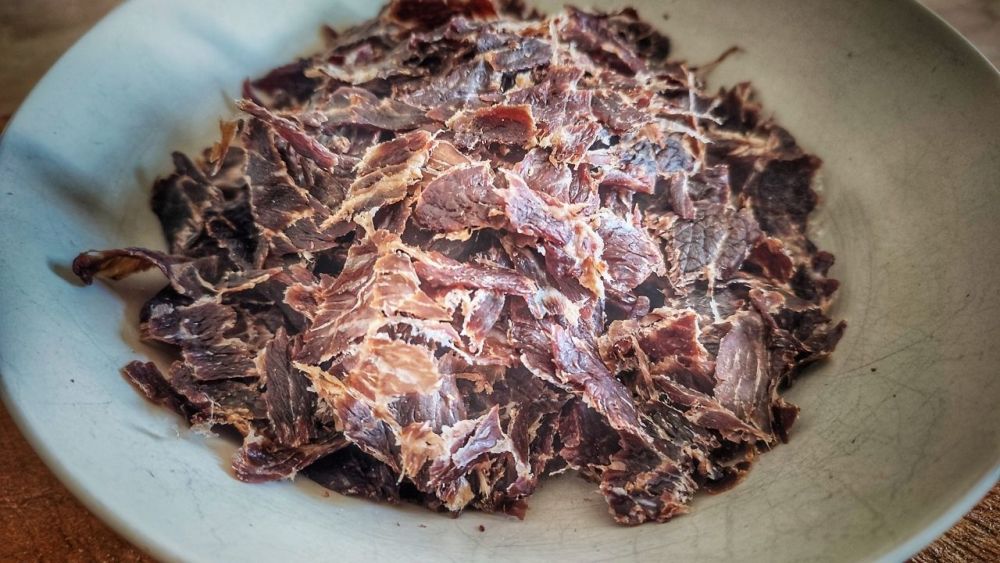
Read also
What is Pemmikan? The original, sustainable, and protein-rich superfood (+3 recipes) – Pemmikan is a food made from dried meat and fat, invented by Native Americans. Read here how to make it yourself.
The Edible Offal – Nutrient-Rich Powerhouses
The organs, often referred to as “offal” or “organs,” are true nutrient powerhouses and have been highly valued. They often contain more vitamins and minerals than muscle meat.
- Heart: A strong muscle, typically one of the first parts grilled or fried. Very flavorful and tender.
- Liver: Rich in iron and vitamin A. It should be consumed fresh (fried, as liver dumplings or pâté).
- Kidneys: Also very nutrient-rich, often fried or braised. It is important to thoroughly soak and remove the ureters.
- Tongue: Cooked and skinned, a delicacy, very tender meat.
- Spleen: Can also be eaten, often in stews or sausage.
- Lungs: In some traditions, processed as part of dishes or in sausage.
- Brain: Besides its function in tanning, the brain is also edible and very fatty, often cooked or fried.
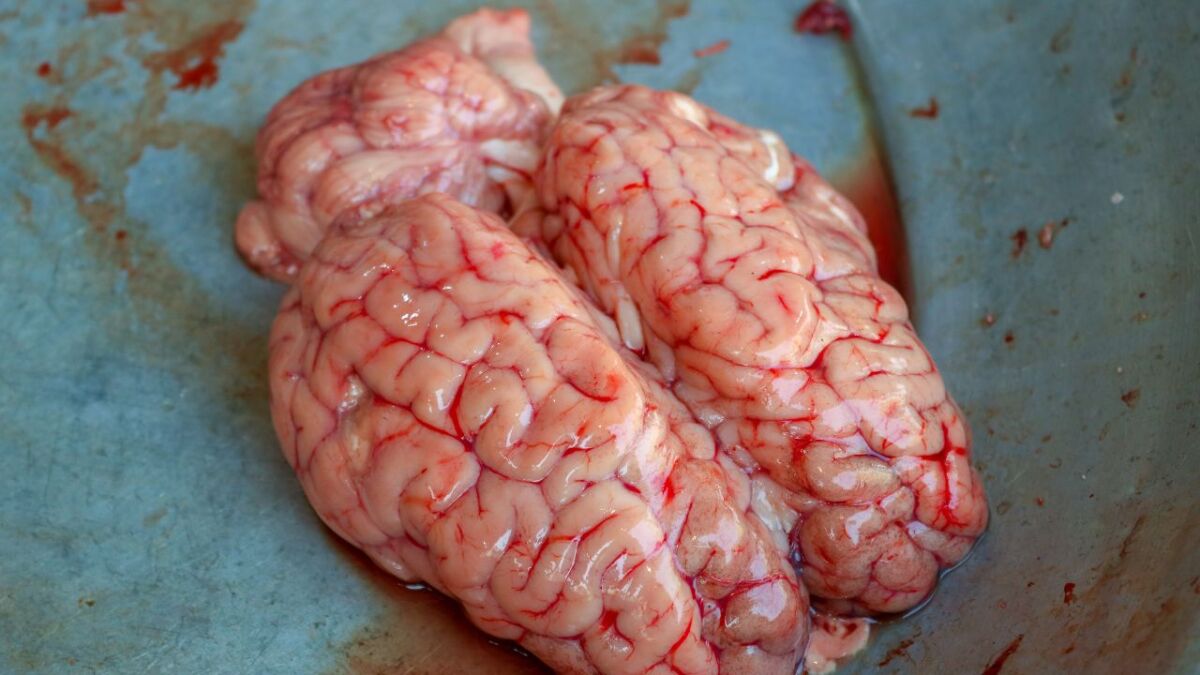
Bone and Cartilage – Bone Broth and Marrow
Bone is not only a material, but also provides valuable nutrition:
- Bone broth: By simmering bones (especially joint bones with cartilage) for a long time, an extremely nutritious broth is created, rich in collagen, minerals, and gelatin. It warms, strengthens, and provides essential building blocks for the body.
- Bone marrow: The marrow from large long bones is very fatty and nutritious. It has been extracted and eaten or used as an energy-rich addition to other foods.
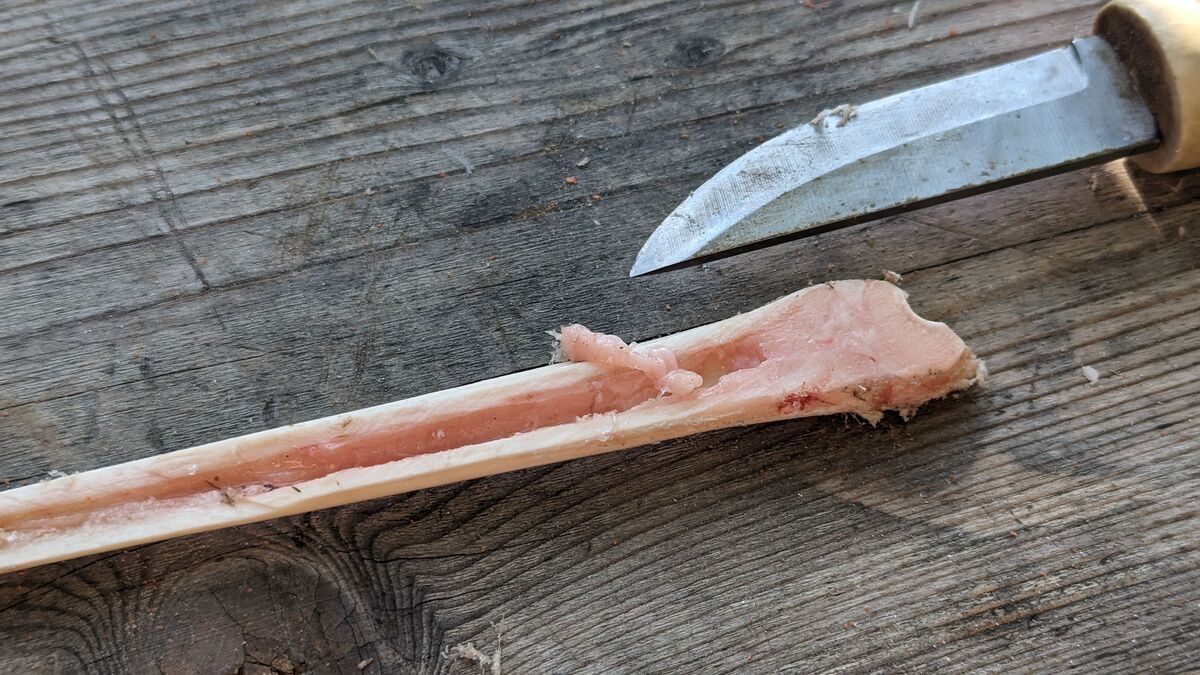
Fat – Energy, Flavor, and Preservation
Deer fat (tallow), especially the kidney fat, was rendered and collected.
- Cooking fat: Rendered tallow served as a valuable frying and cooking fat.
- Energy supplier: Fat is a concentrated energy supplier, especially important in lean times or cold climates.
- (Preservation): Sometimes, cooked meat was covered in pots with a layer of rendered fat (similar to confit) to make it last longer.
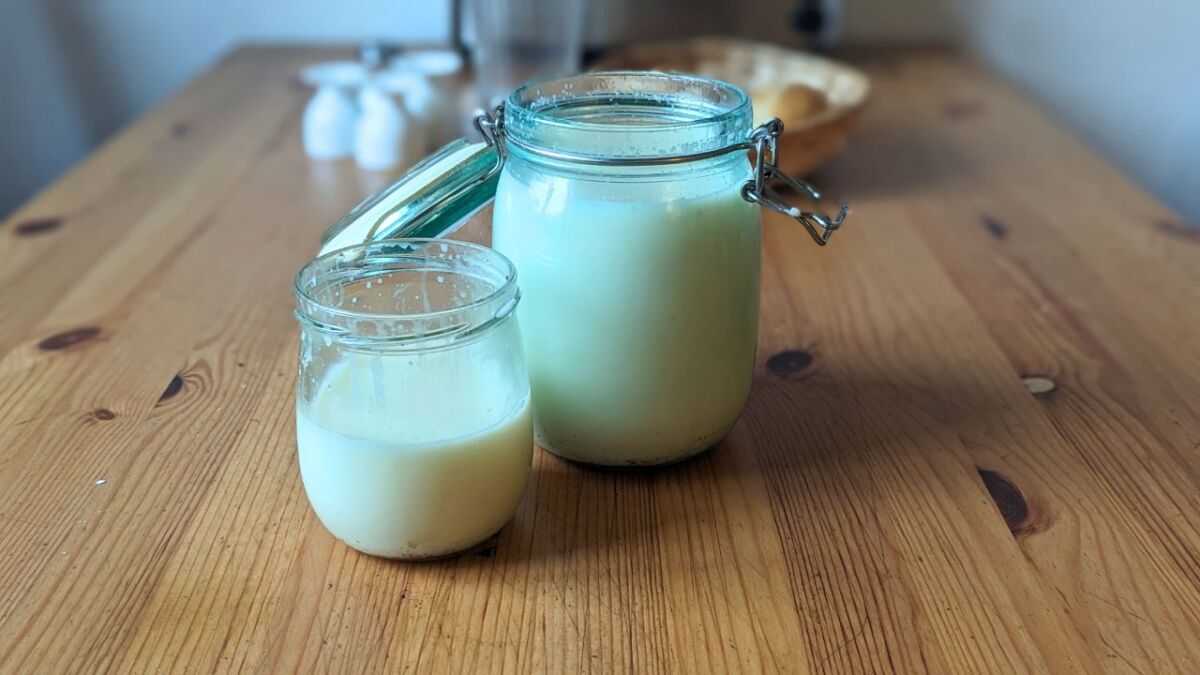
Skin and Hair: the Versatile Outer Covering
After the animal has been butchered and the food secured, one turns to the other materials, starting with the outer shell.
The outer layer of the deer offers much more than just protection from the elements. It can be processed and used in various ways, from soft clothing to stiff containers.
Suede – The tanned leather for clothing and bags
The deer hide is an incredibly versatile material. The most well-known is probably the production of soft, breathable leather through traditional methods such as brain tanning (Buckskin). This leather served as the basis for clothing, shoes (moccasins), bags, and pouches.
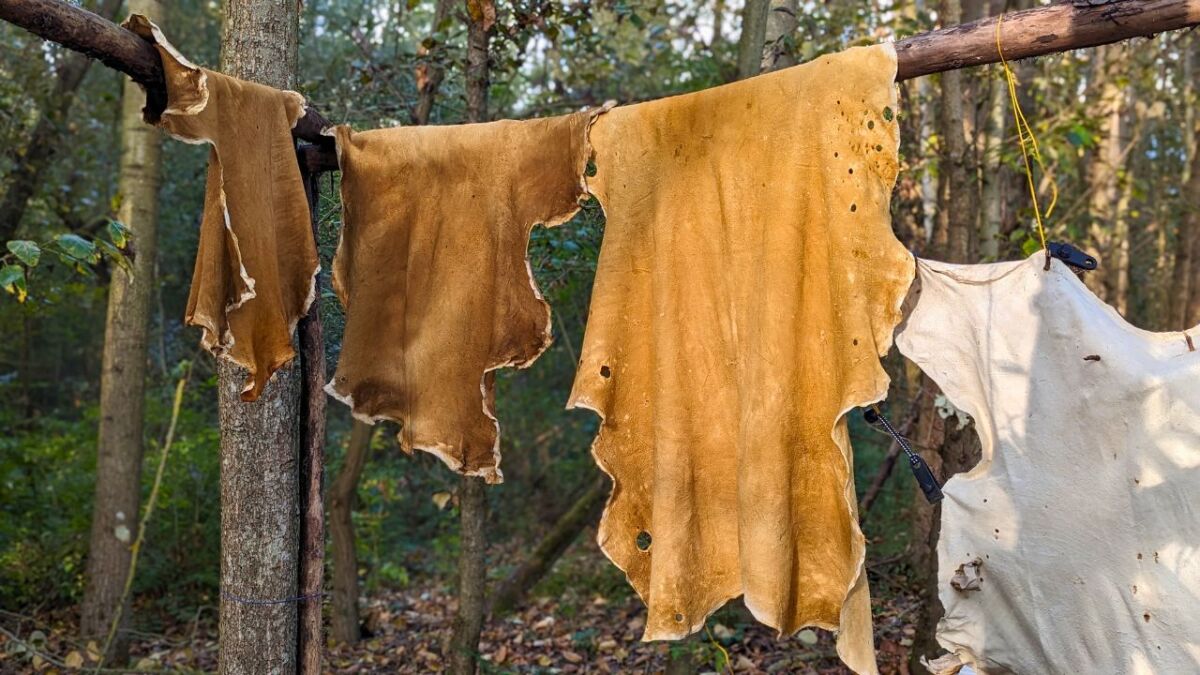
Through tanning, the rawhide is made durable and protected from rotting. The softness and wearing comfort of genuine buckskin are unparalleled.
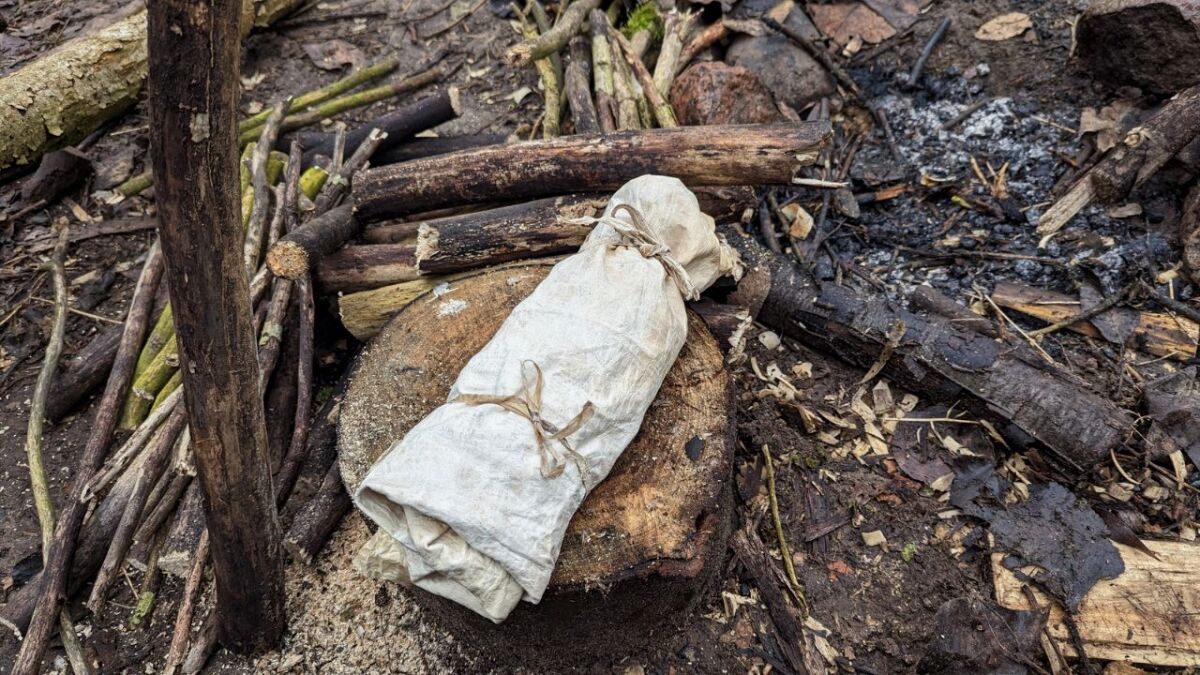
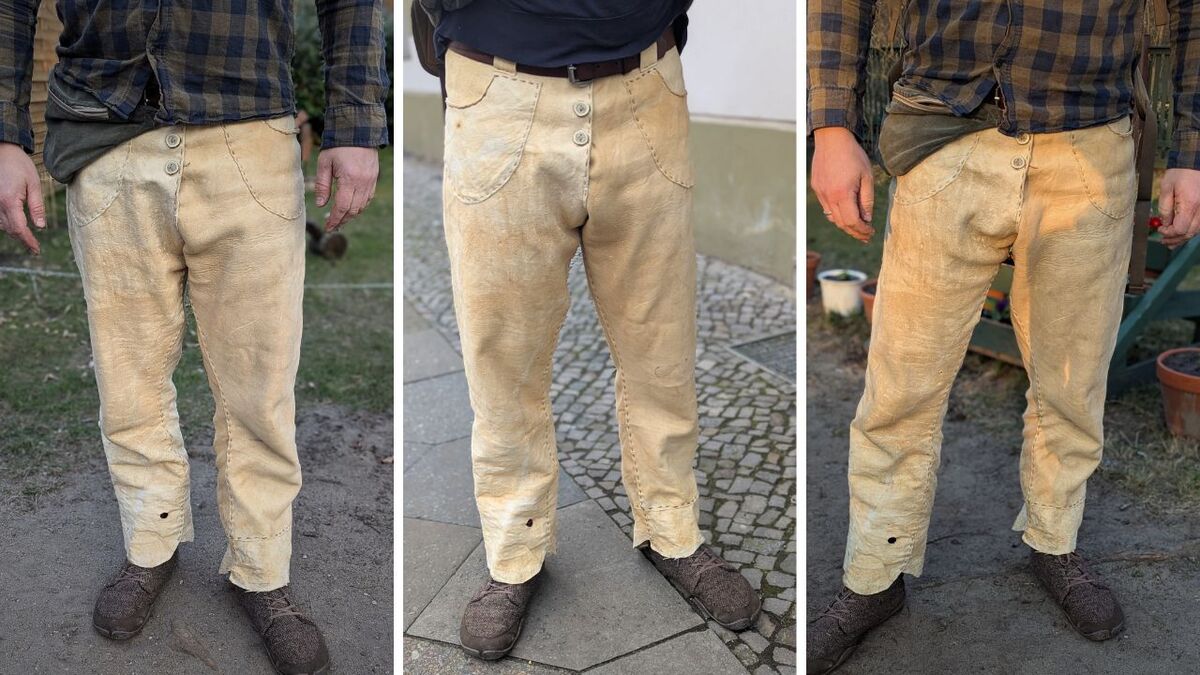
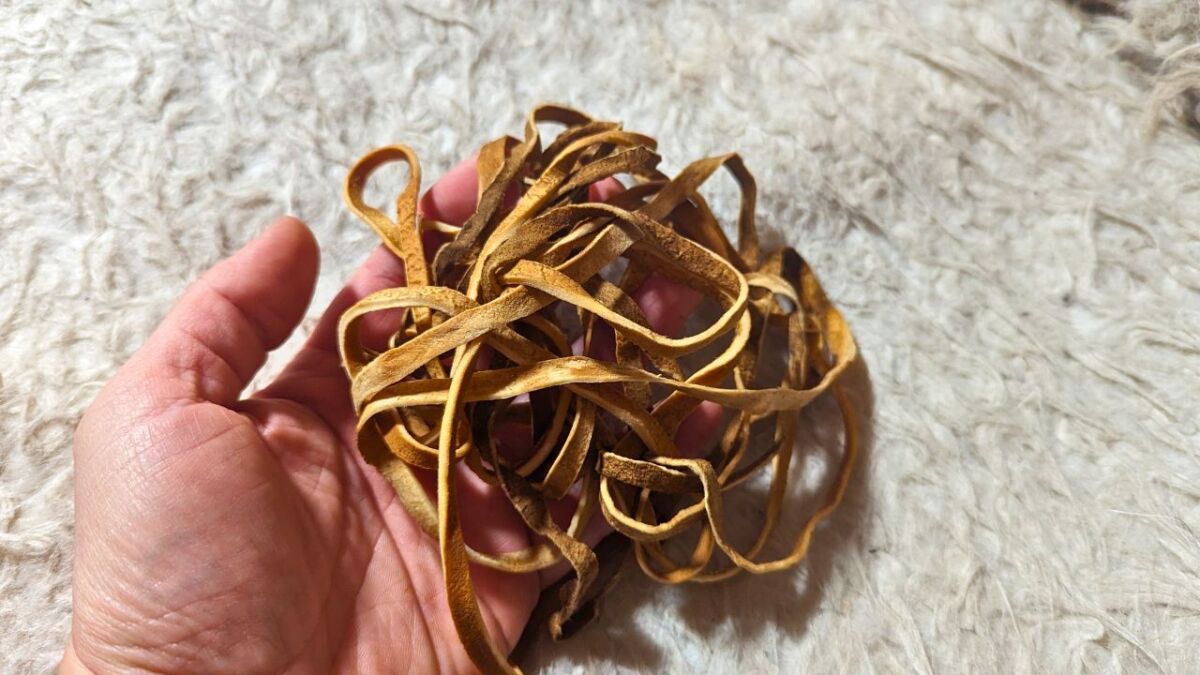
Rawhide – Uncured, stiff, and strong
If the skin is merely freed from meat residues and hair (scraped) and then dried, rawhide is produced.
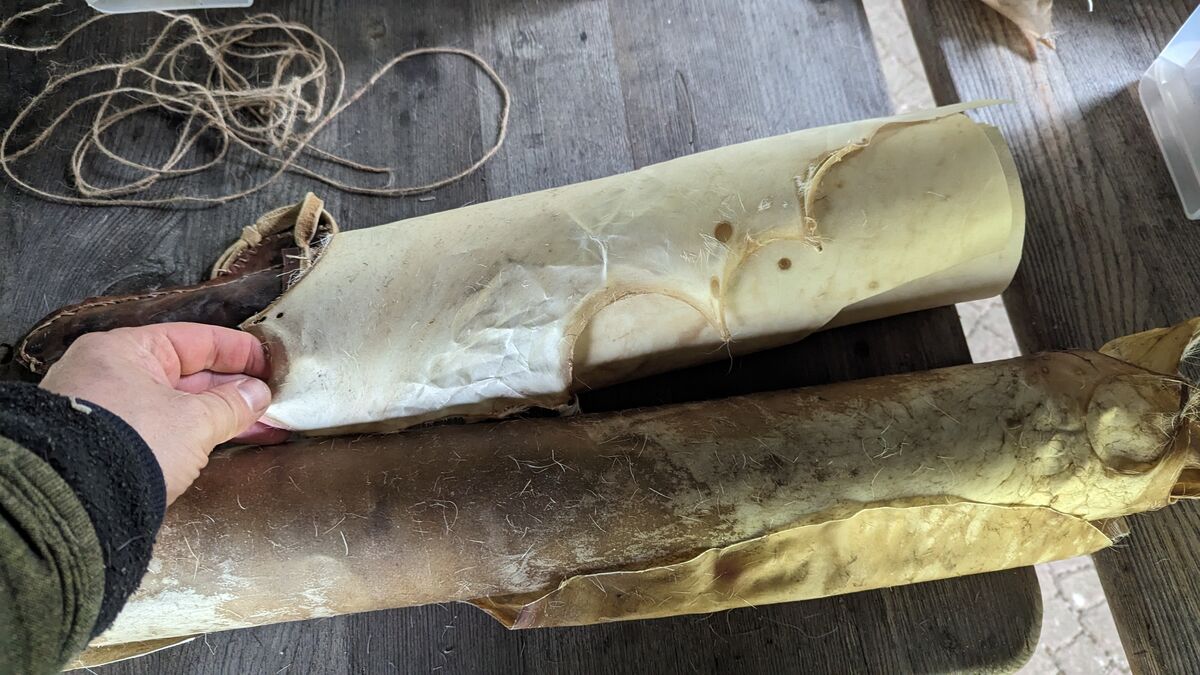
In contrast to leather, rawhide is very stiff, hard, and extremely resistant to abrasion in its dry state.
When it gets wet, it becomes flexible and moldable again, but it shrinks significantly when drying. These properties make it ideal for:
Strong Cords and Straps (Rawhide Cordage): Cut into strips while wet and dried, they create extremely tensile connections.
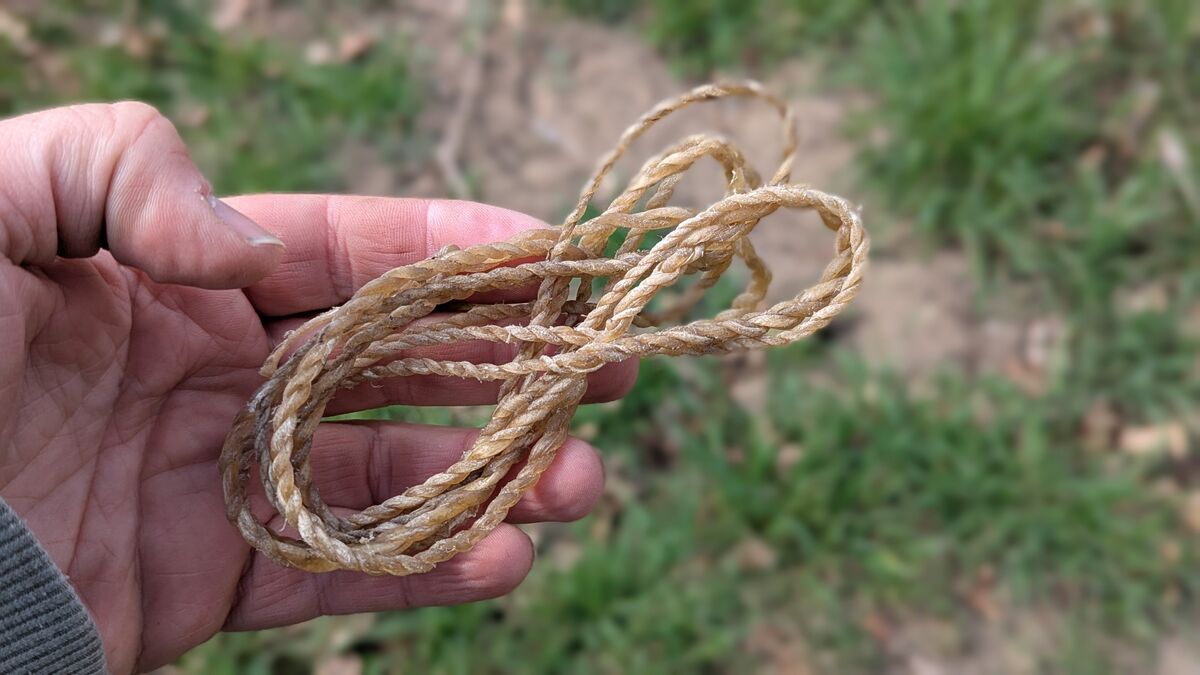
Stretches: Perfect for drums or historically, also shields, as they build up high tension when drying.
Container: Stretched and dried over a mold, rawhide retains its shape and results in very sturdy boxes or pouches (“Parfleche”).
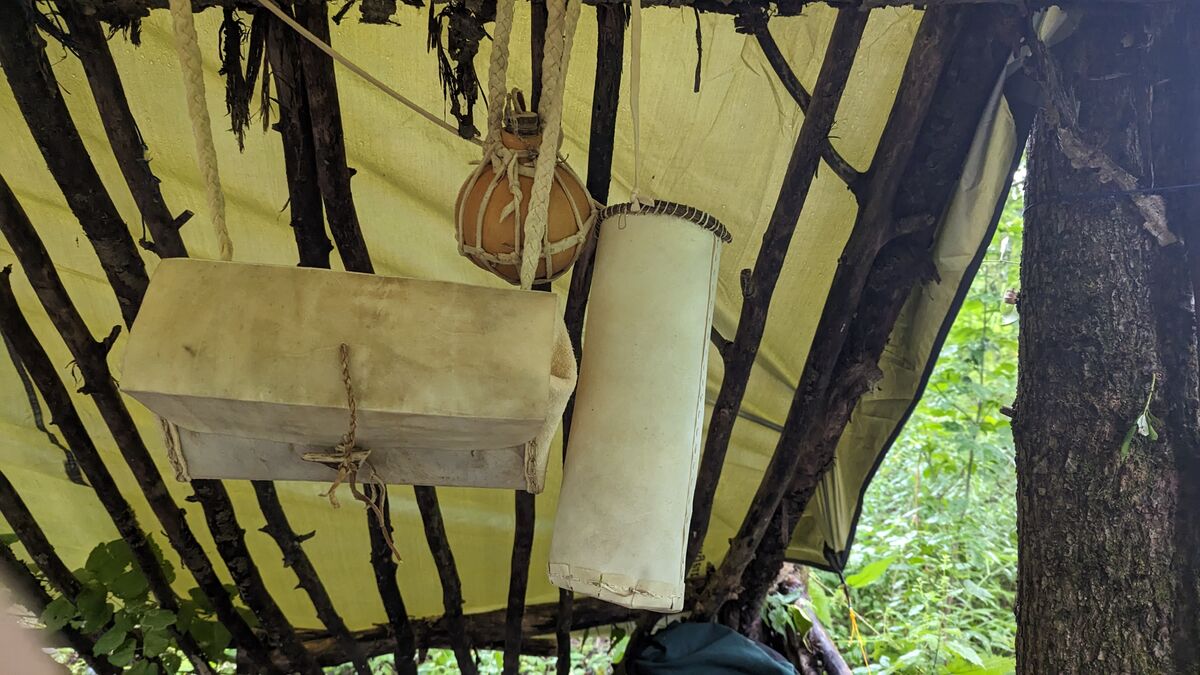
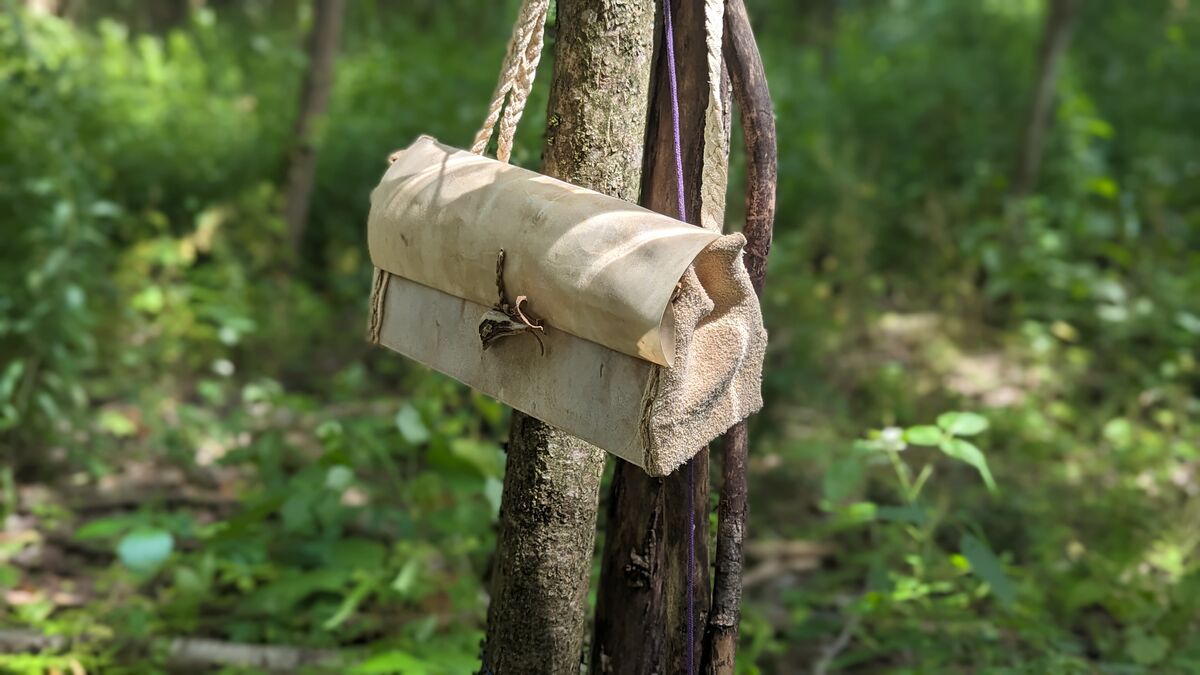
Connections/Windings: Wet rawhide strips tighten around tool shafts or repair points as they dry, ensuring a rock-solid connection.
Skin glue extraction: Raw hide is the starting material for the production of strong skin glue through boiling.
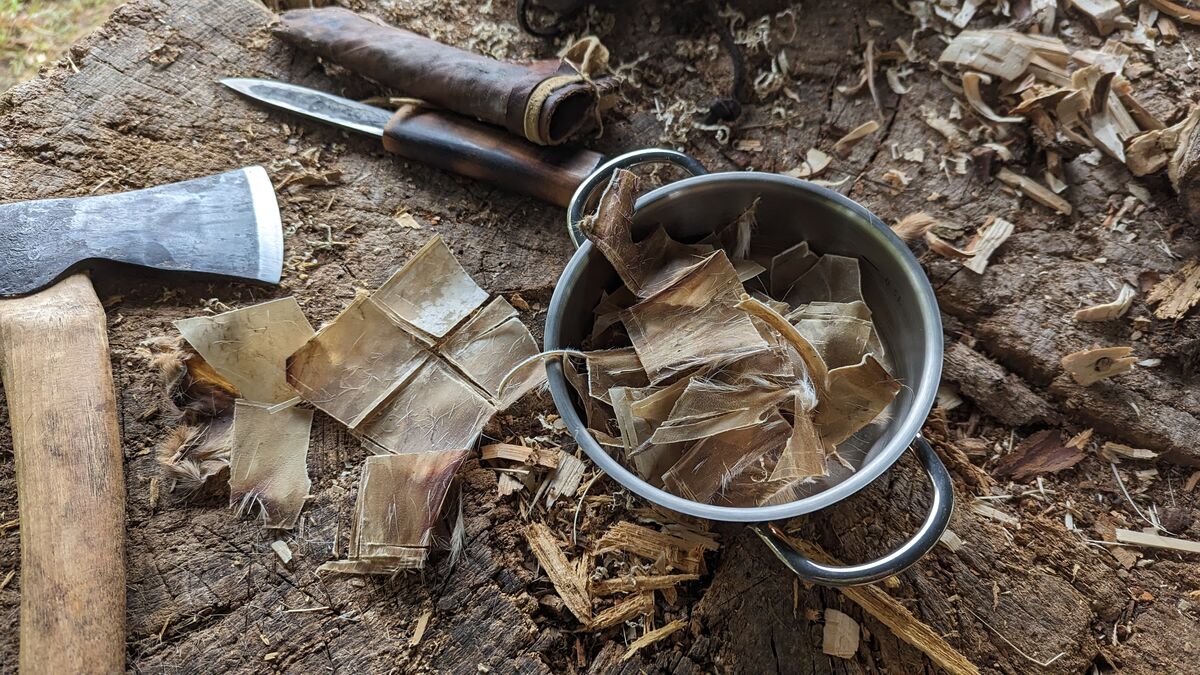
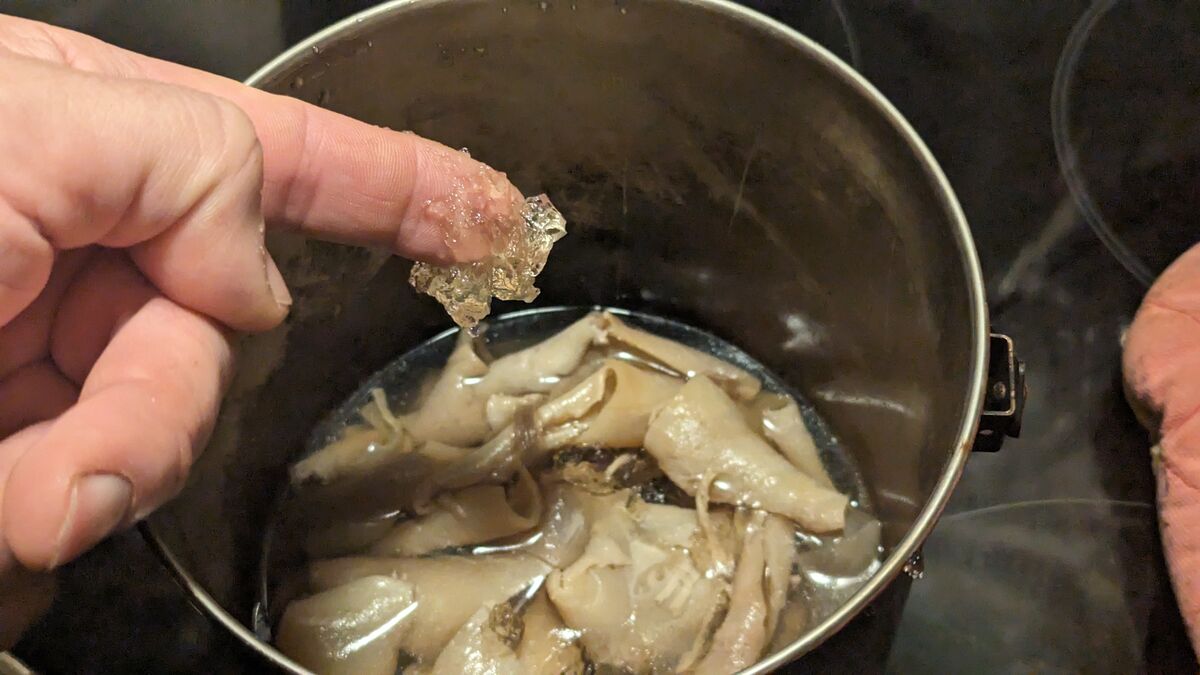
The Hair – Warming Filling
The dense coat of the deer, especially the winter coat, consists of hairs that trap air (as they are hollow) and thus provide good insulation.
These hairs were not disposed of, but served as filler material for improvised pillows, as an insulating layer between clothing layers, or as padding in dwellings.
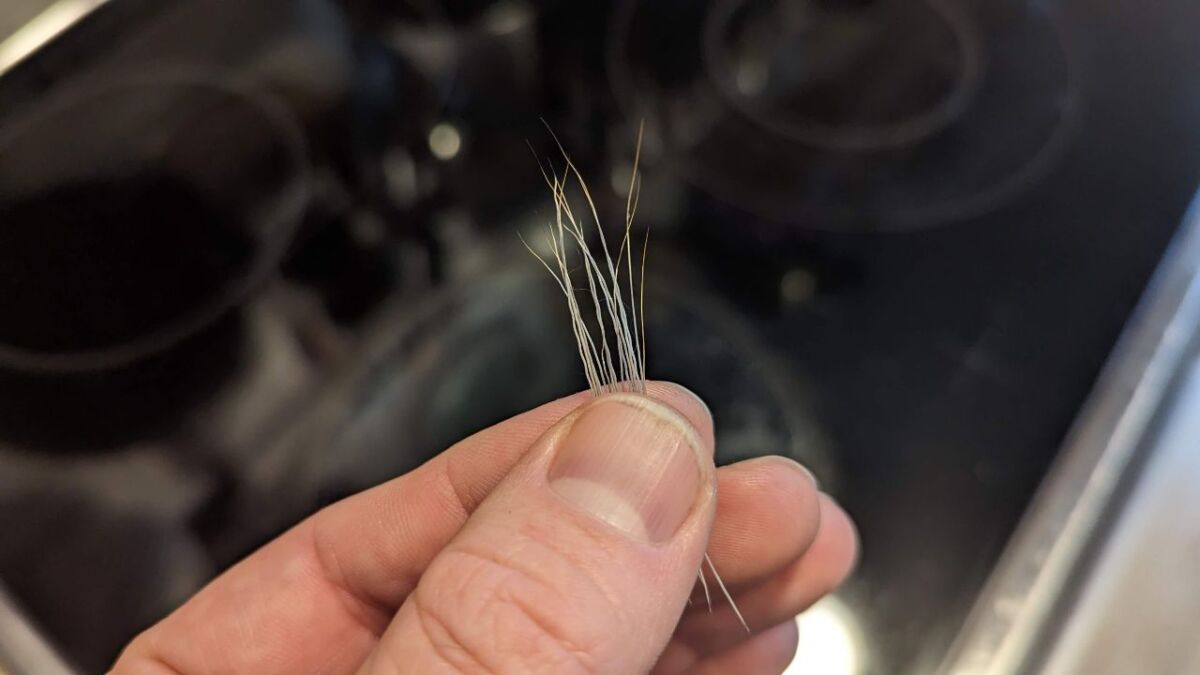
Bone and Antler: Nature's Toolbox
The skeleton of the deer is a true treasure trove of robust and versatile materials that represented the steel of our ancestors.
Bone Tools – Awls, Needles, Blades
Essential tools could be made from the sturdy tubular bones. Sharp, polished bone pieces were turned into awls, with which holes were punched in leather or bark. Even more finely worked and provided with a drilled eye, needles for sewing were created from them.
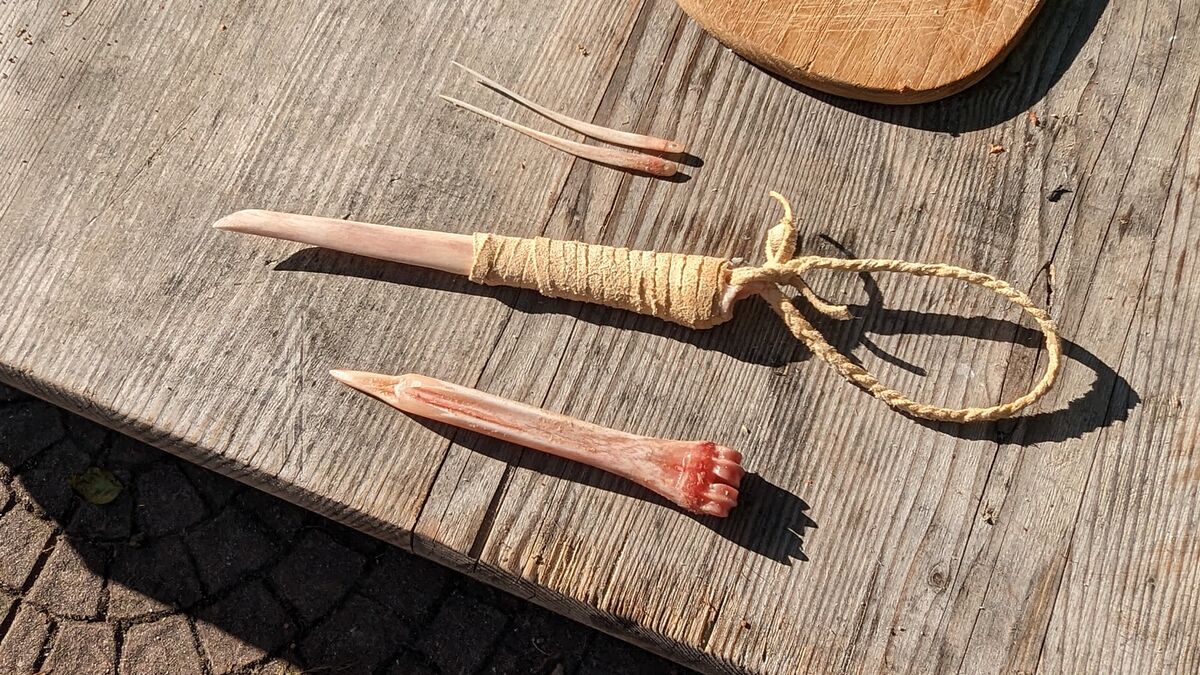
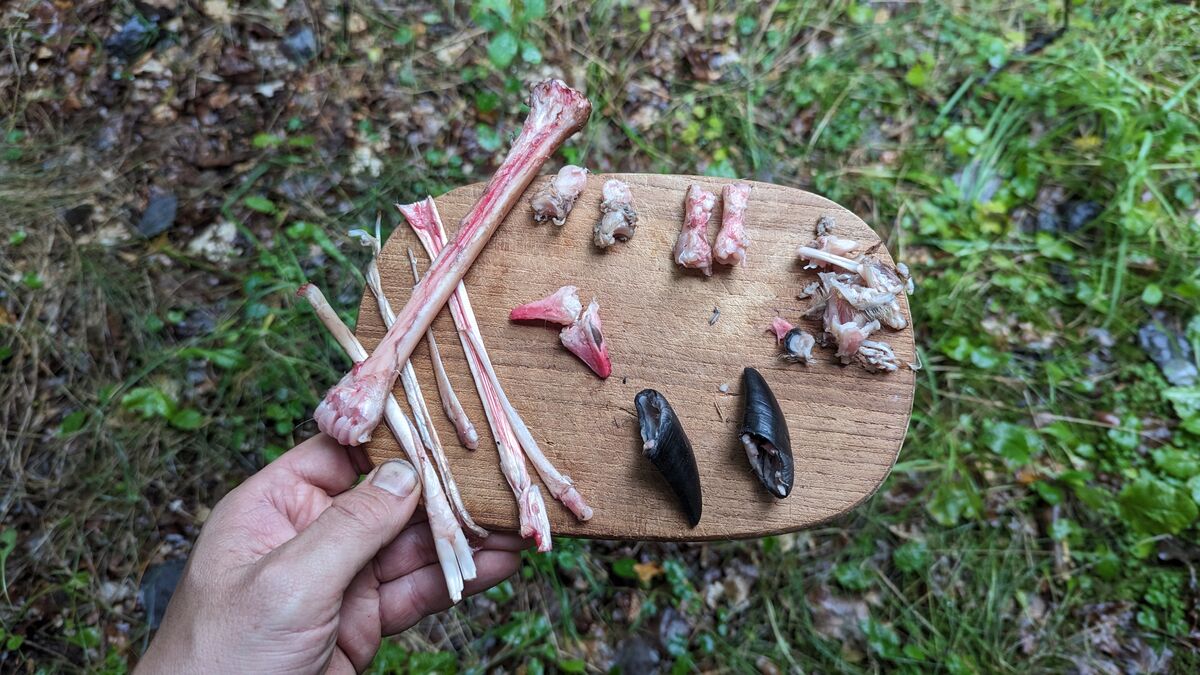
Flat bones like the shoulder blades or longitudinally split tubular bones could be sharpened into sharp knives and scrapers, ideal for skinning hides, cutting plant fibers, or working wood.
Special Bones – Fishing Hooks and Fire Drill Aid
Certain bones are suitable for special applications. Small, pointed bone shards could be carefully shaped into stick-shaped fishing hooks (“Gorge Hooks”) – a simple but effective fishing method where the hook turns sideways in the fish's throat.
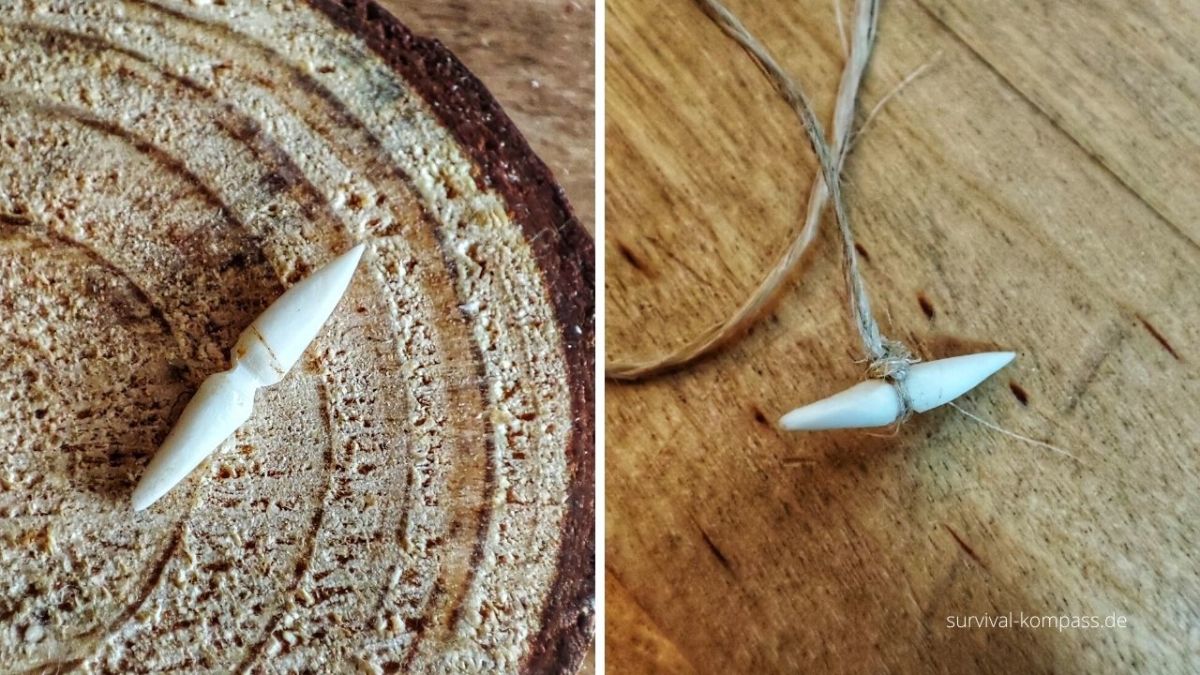
But you can also make regular fishing hooks, as most people know them, from the bones of a roe deer.
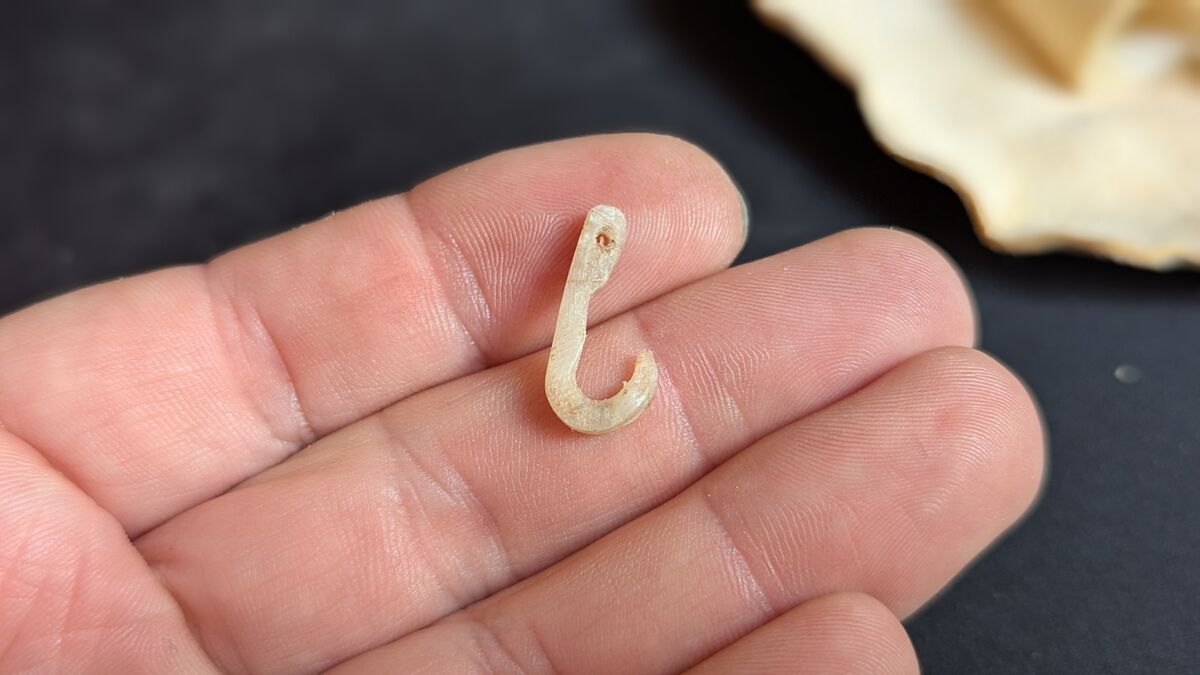
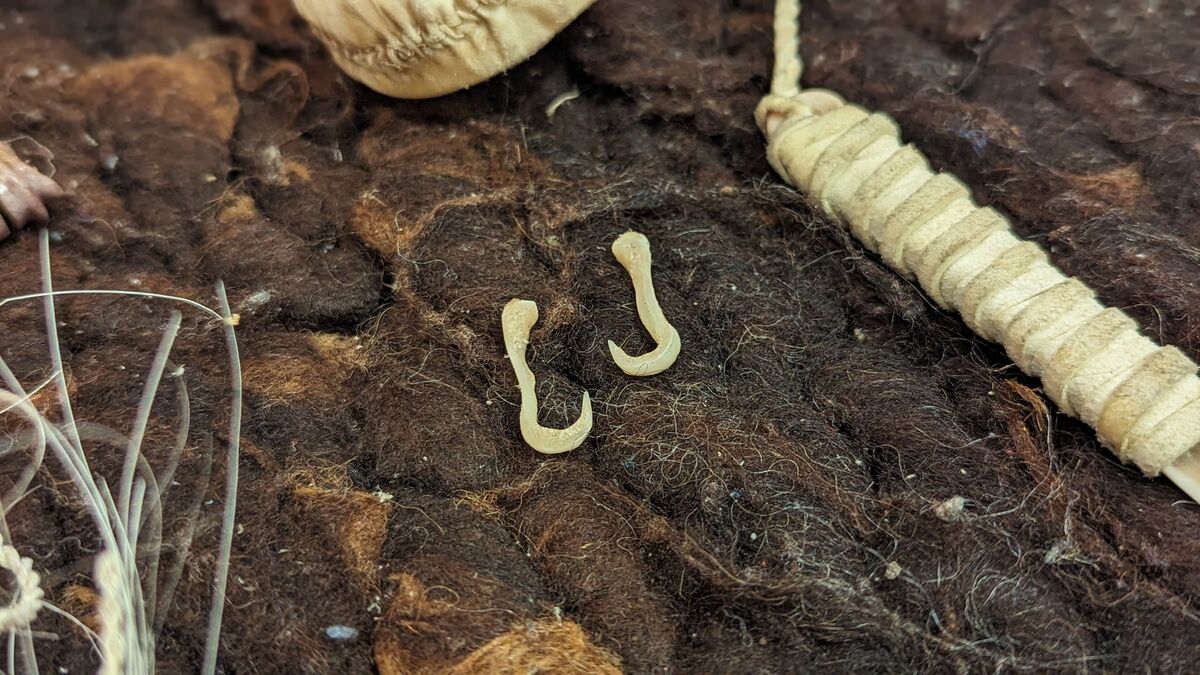
A natural indentation in the pelvic bone provides the perfect grip and serves as the upper bearing block for the bow drill. It allows you to apply pressure to the spindle without burning your hand or slipping.
Further Bone Use – Glue, Containers, Jewelry
By boiling bones and cartilage scraps for a long time, a strong bone glue is produced, similar to skin glue.
Small, hollow tubular bones could serve as protective containers for delicate bone needles or tinder. Smaller bones, vertebrae, or shapely pieces were made into beads, pendants, or other jewelry pieces.
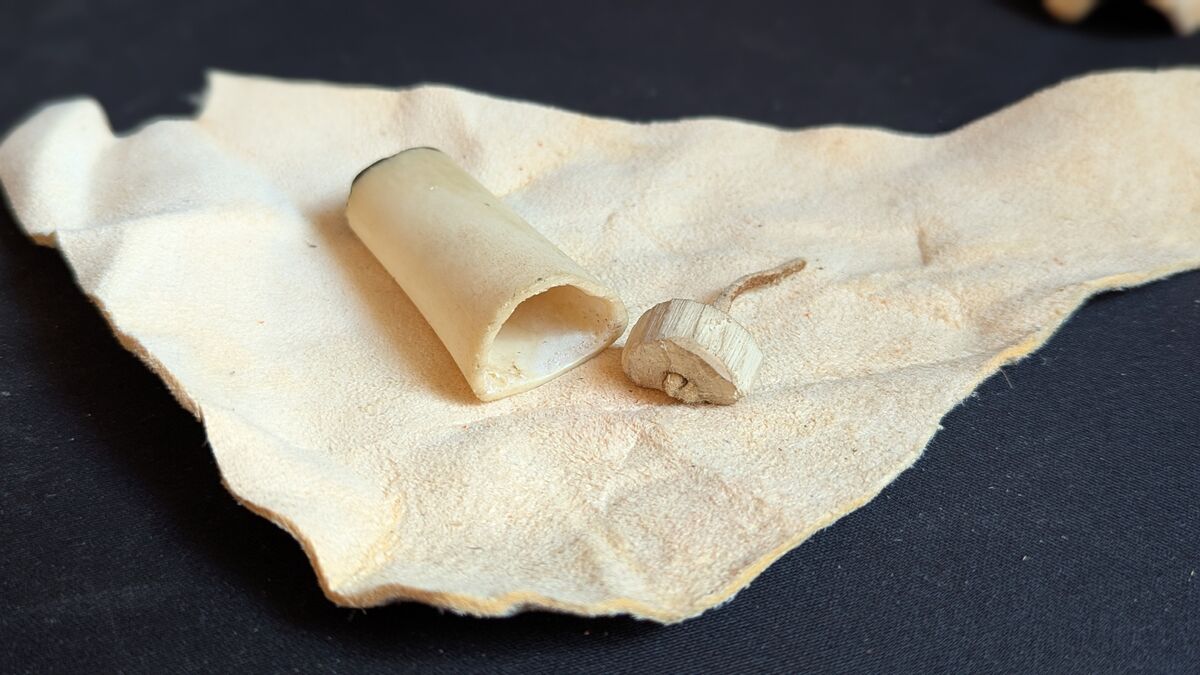
The Antlers (if present) – Hard Material for Special Tools
The antlers of male deer (or other stags) are an extremely hard and tough material.
It was used for tools that had to withstand high stress:
- as hammer head (billet) for striking flint blades
- as pressure flaker for fine working of stone tools
- as a sturdy handle for knives
- as a toggle for tensioning strings
Of course, it also served as material for jewelry and ritual objects or buttons.
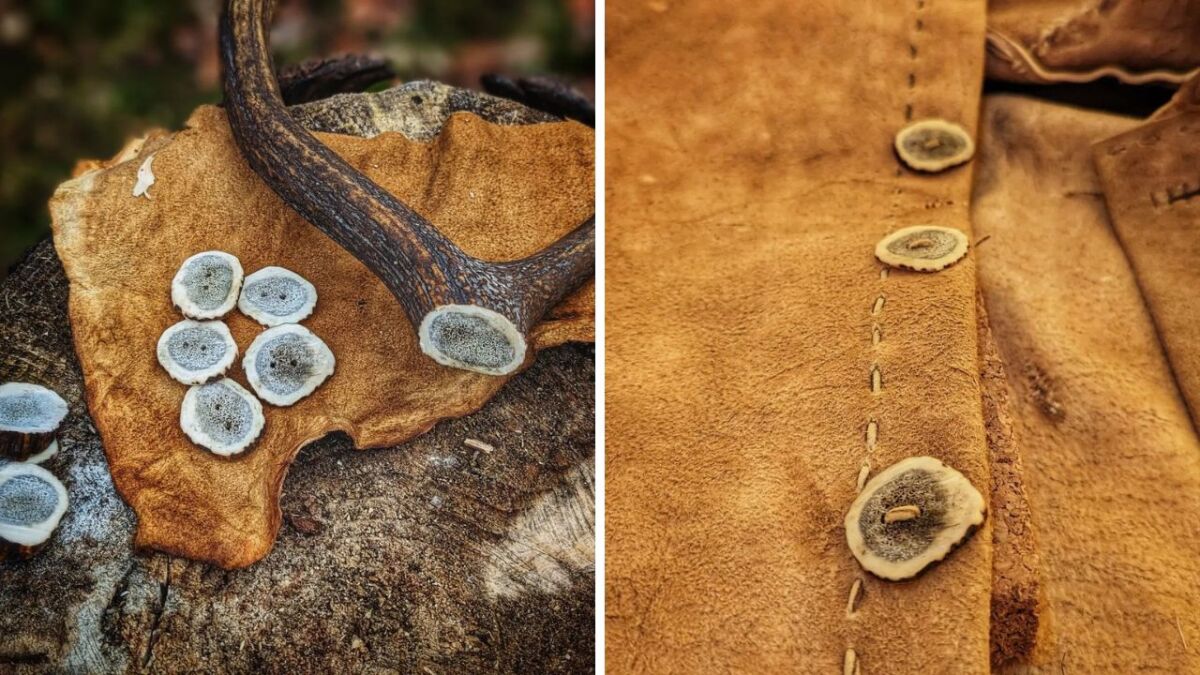
Tendons and Connective Tissue: The Threads of Life
In the body of the deer, there are extremely strong, fibrous structures that were essential for the production of strings.
Tendon fibers – Tear-resistant thread and cord
The long, strong tendons, primarily along the spine (back cord) and in the legs, are a source of incredibly tear-resistant fibers.
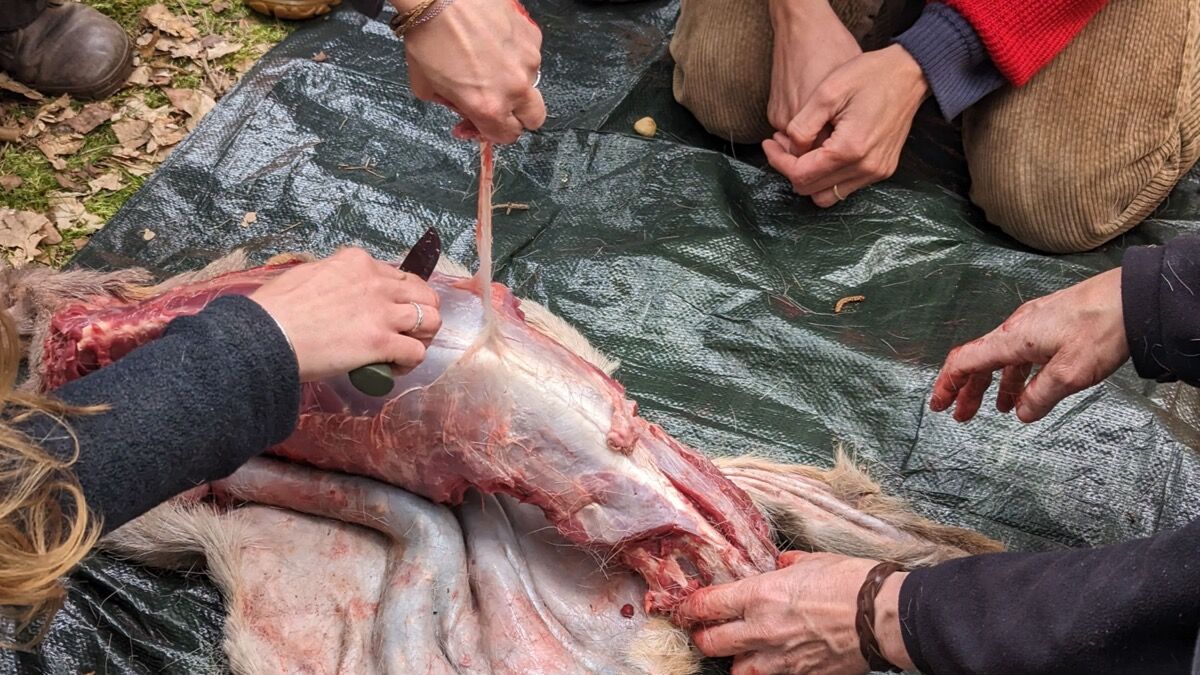
After drying, they are carefully beaten and rubbed between the fingers to split them into individual strands. These fine fibers can then be twisted into extremely durable sewing thread or sturdy cords.
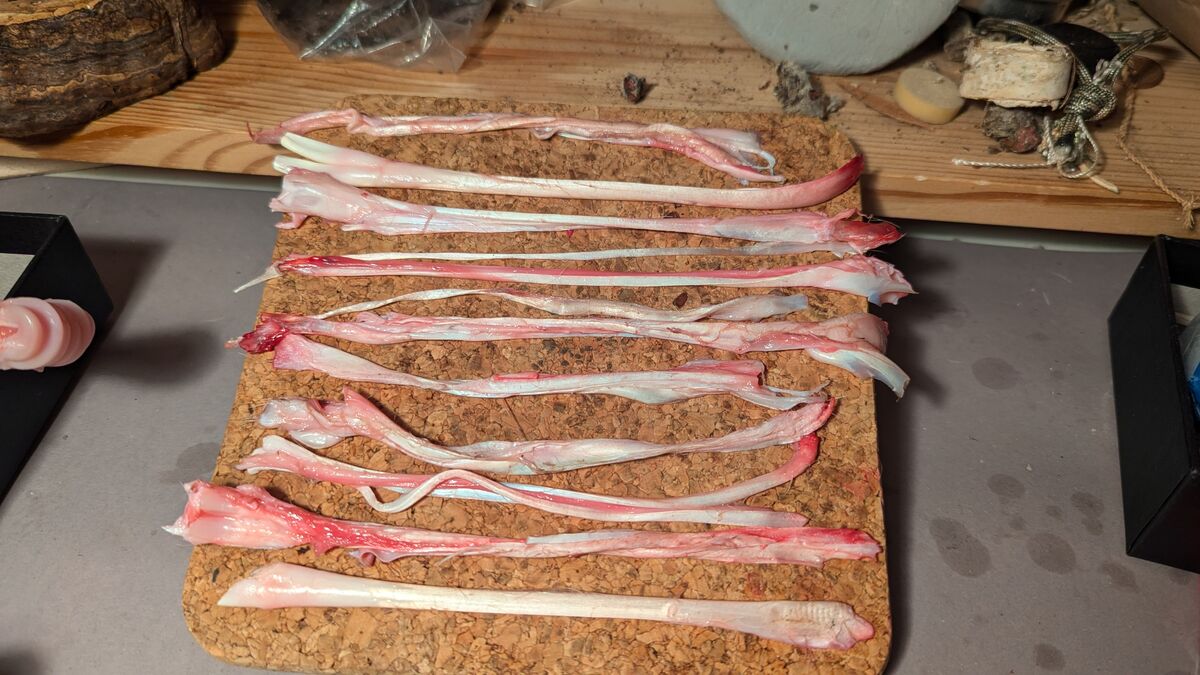
They were used for sewing leather clothing, for attaching arrowheads and tool blades to the shaft (hafting), for making nets, traps, and even as a traditional material for bowstrings.
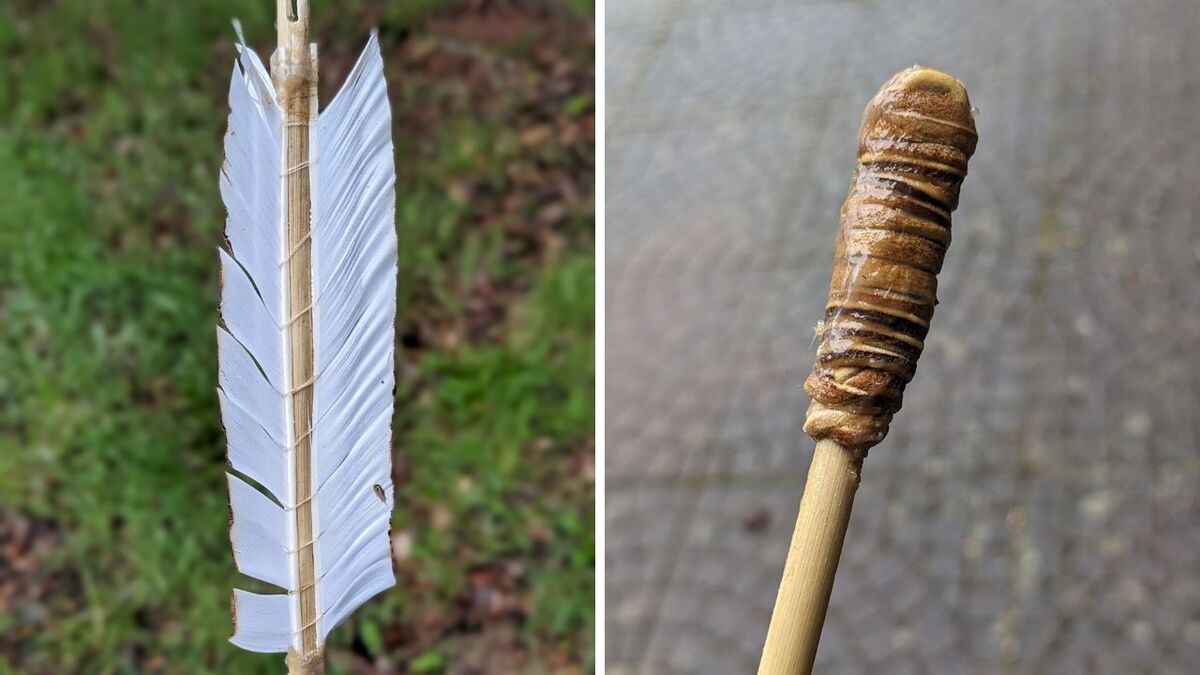
Innards (not edible) and bodily fluids: Further potential
In addition to edible organs, other entrails and even bodily fluids provide valuable resources for craft and technology.
Stomach, Bladder and Intestine – Flexible Containers and Membranes
After thorough cleaning and drying, the stomach and bladder can be processed into surprisingly resilient, waterproof bags.
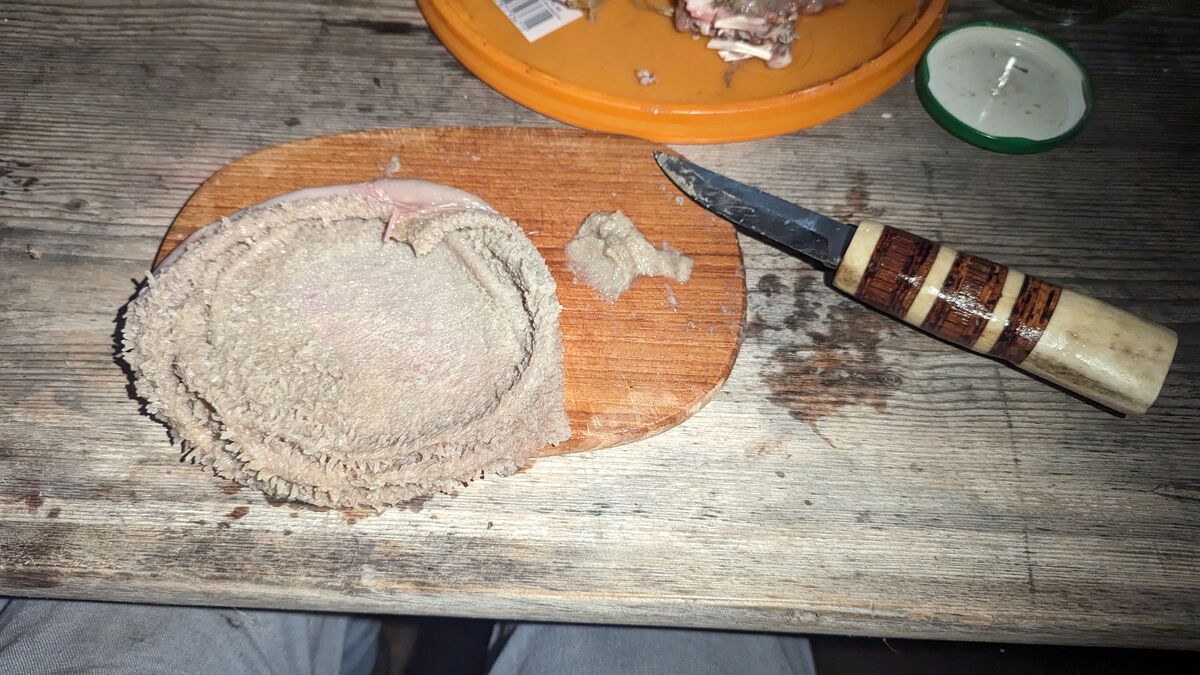
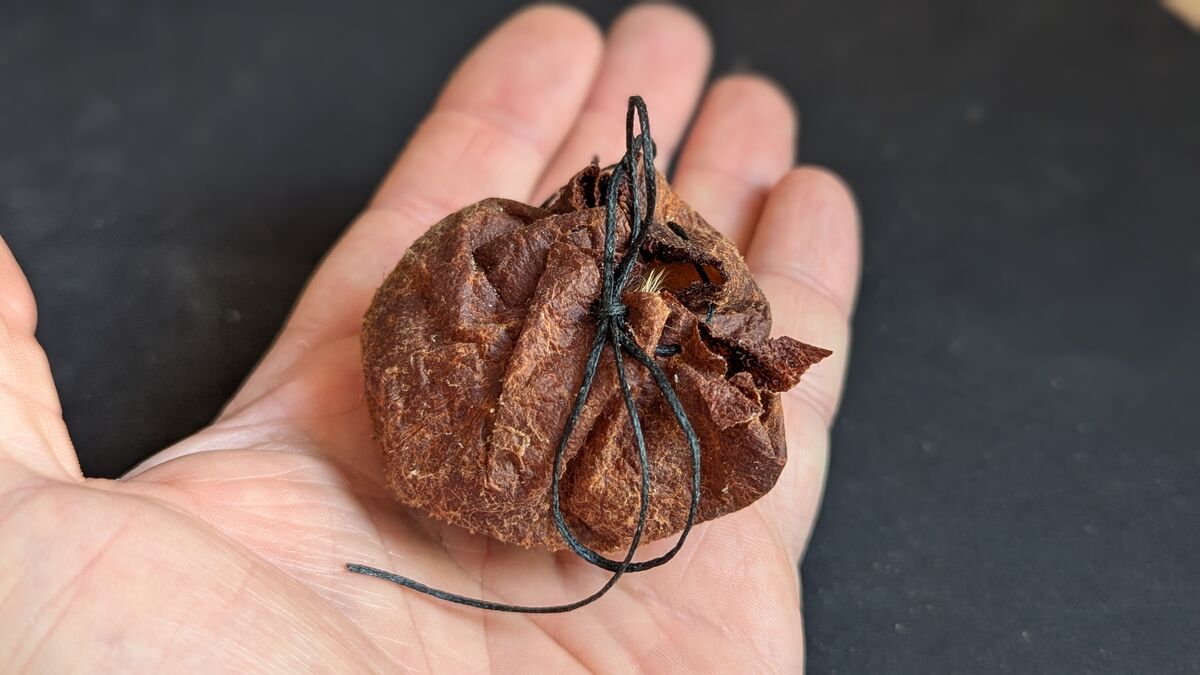
They were used for transporting water, loose food, or other items. The intestine, cleaned and dried, provided thin but strong strings or could be used as a membrane (e.g., for drums).
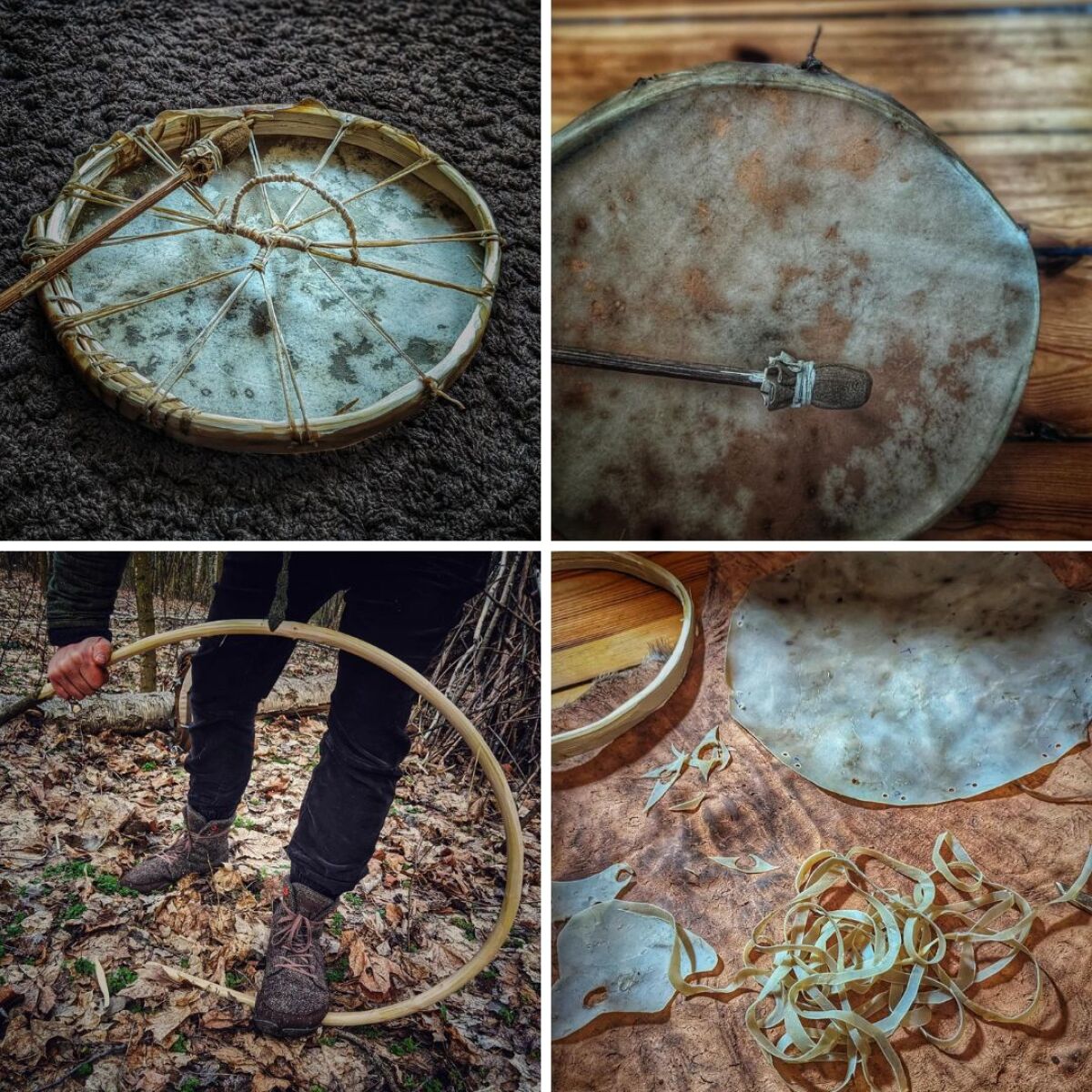
Transform simple natural materials into a powerful instrument! Find out how to create your own rawhide drum with patience and skill – the building instructions are waiting for you here.
The Brain – Key to Leather Production
The brain of the deer contains emulsifying fats and lecithin, making it the perfect natural substance for traditional brain tanning.
It helps to break down the fiber structure of the skin and make it soft and durable – a perfect cycle in which the animal itself provides the material for its refinement.
Eye Fluid – Natural Color Binder
The gelatinous liquid inside the eyeball (vitreous body) is a traditional binding agent for natural color pigments.
With it, crushed earths, coal, or minerals could be mixed to create durable colors for body painting, the decoration of tools, leather, or for rock paintings.
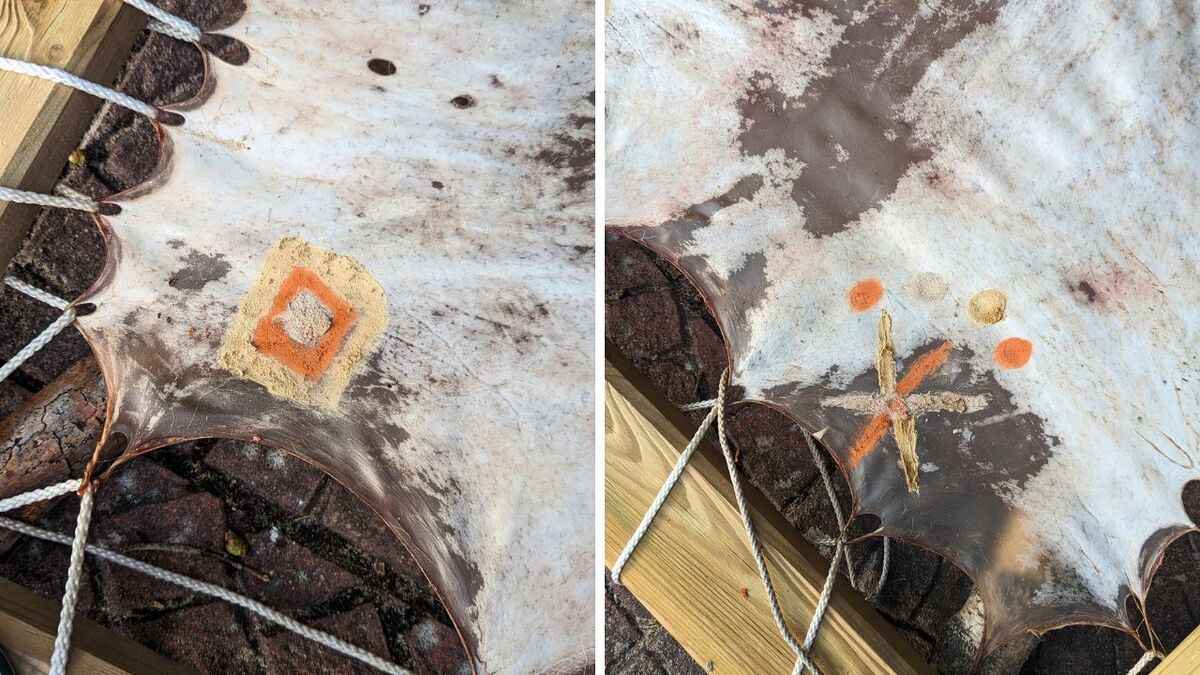
Head, Bowls, and Runs: Use in Detail
Even the often overlooked parts like the head and lower extremities were used purposefully by our ancestors.
Teeth and Ears – Jewelry and Small Pouches
The teeth of the deer, especially the canines or molars, were cleaned and often drilled to serve as unique pendants for chains or as decorations on clothing and bags (jewelry).
The ears, tanned or dried, could be sewn into small, flexible bags or pouches.
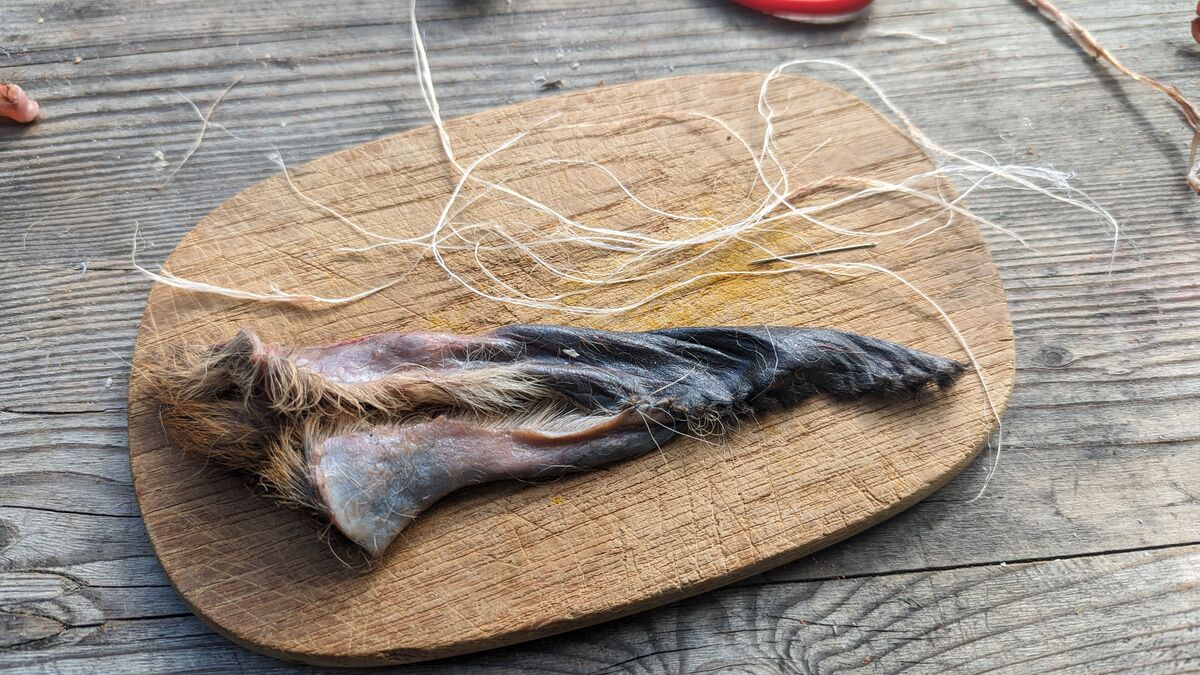
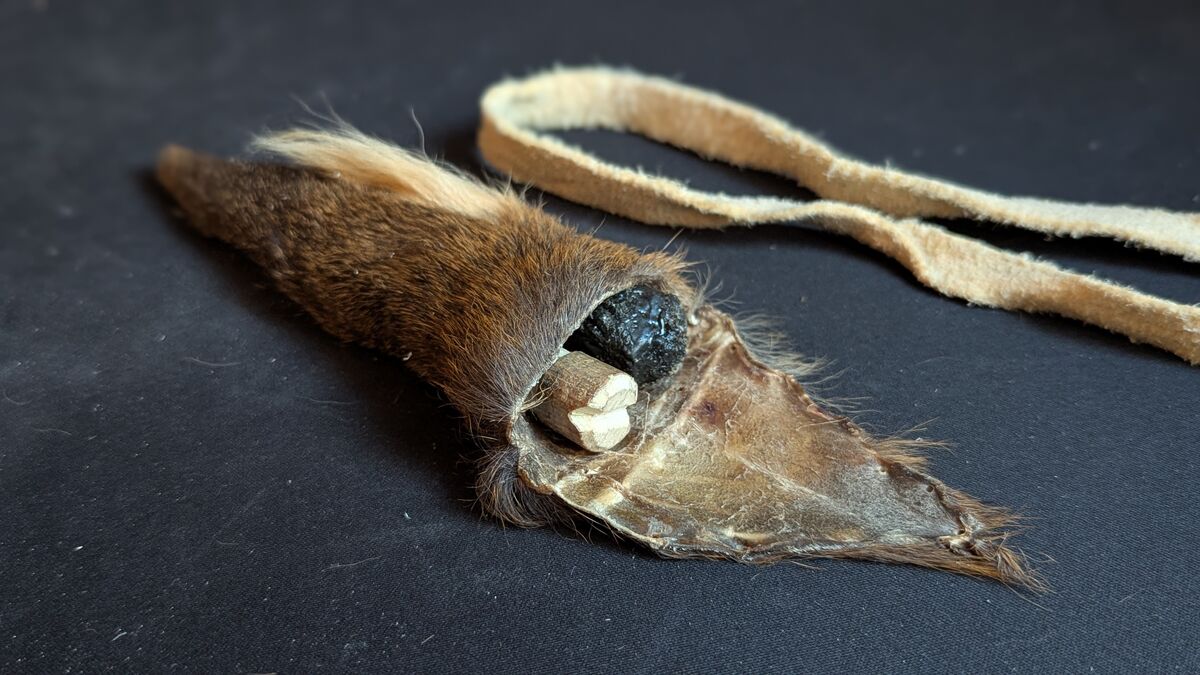
Bowls, Claws, and Underflows – From Rattles to Glue
The hard shells (hooves) could be boiled down to obtain glue. Cleaned and dried, they were often attached to a stick or leather strap to create rhythmic rattles for music or ceremonies.
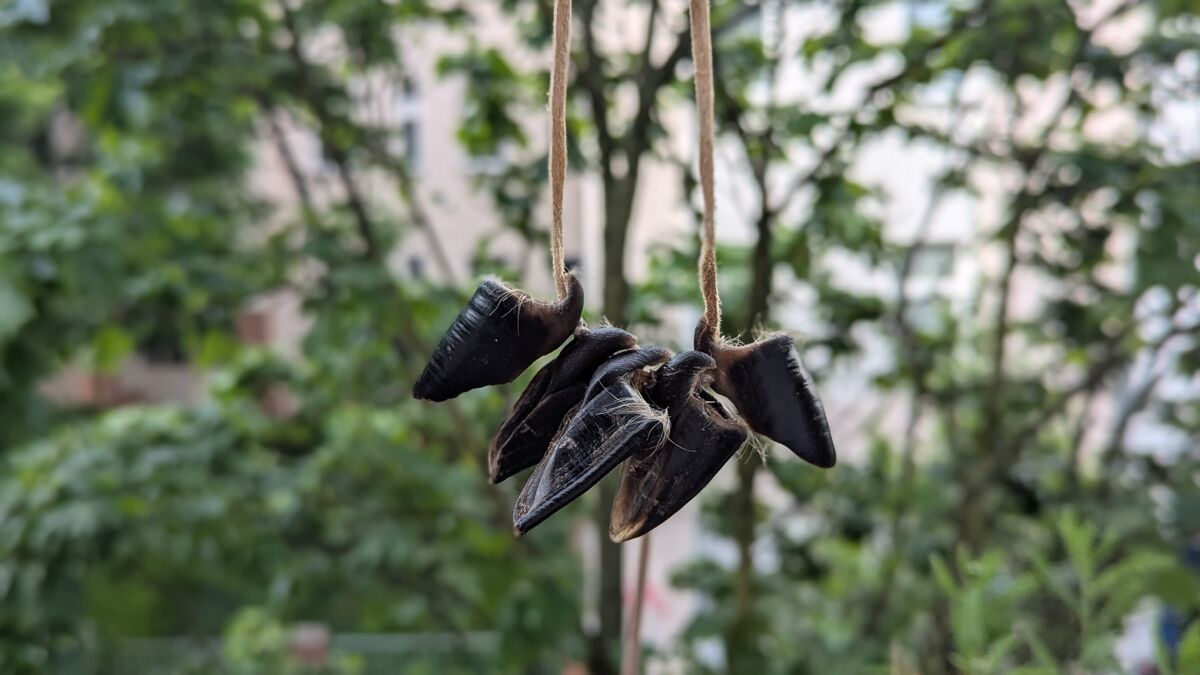
The smaller dew claws were similarly used as rattles or jewelry. The skin of the lower legs is particularly robust and is well-suited for especially durable small bags or as reinforcement material.
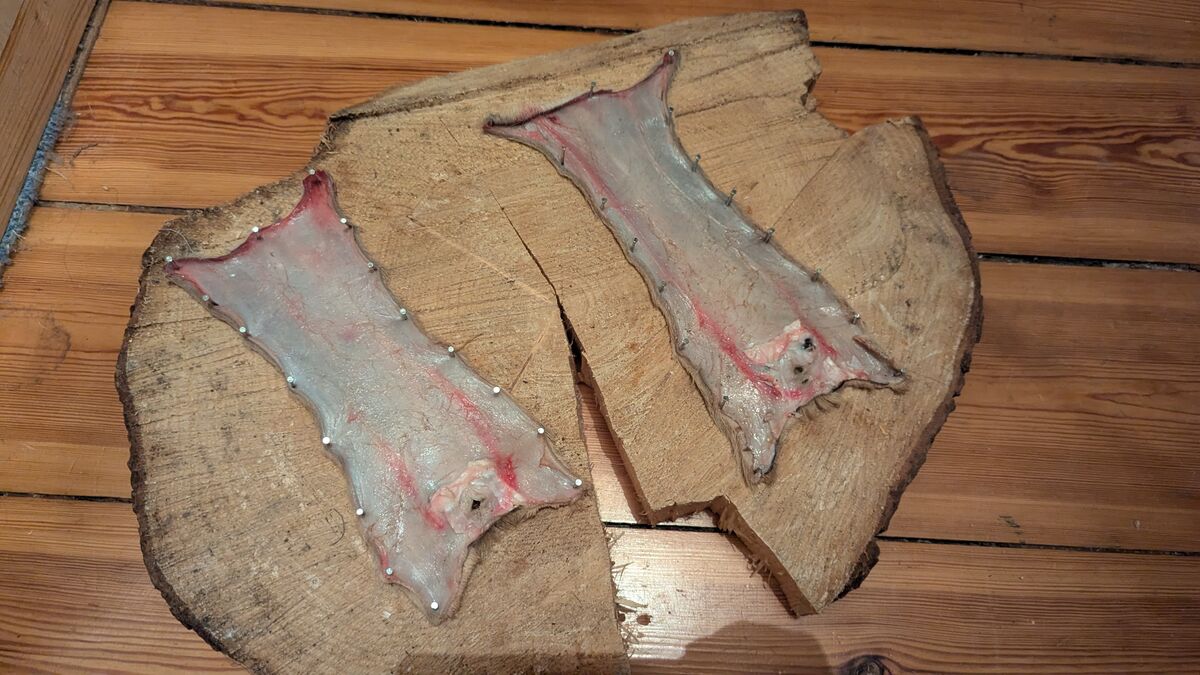
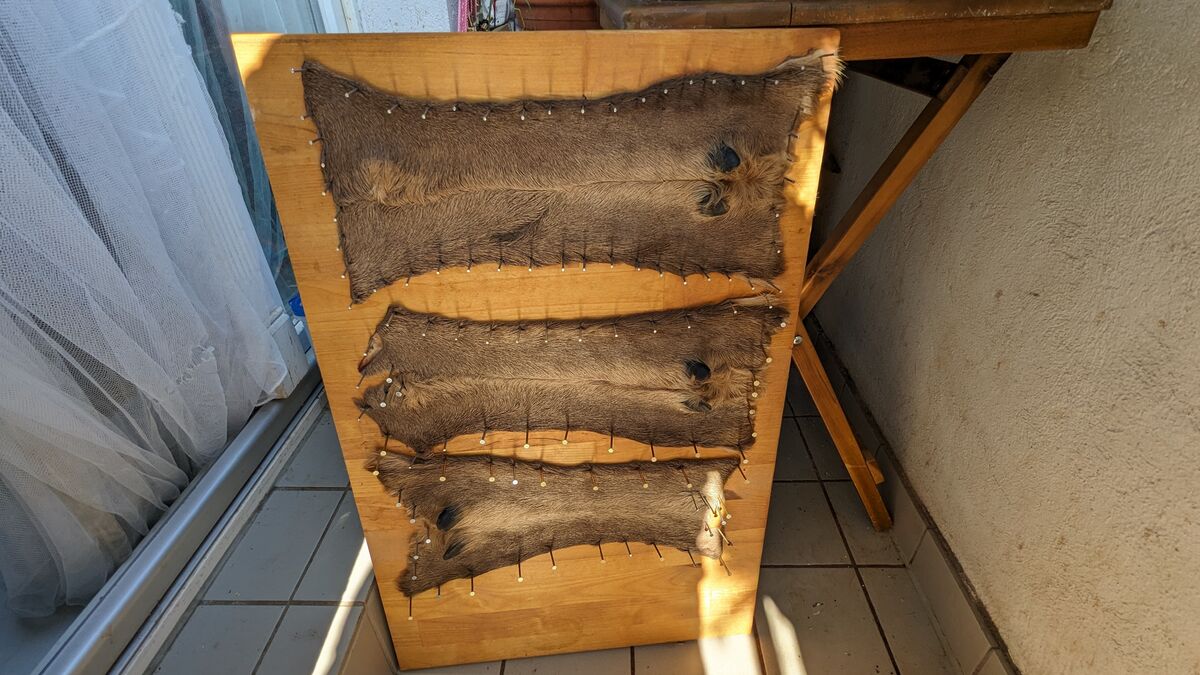
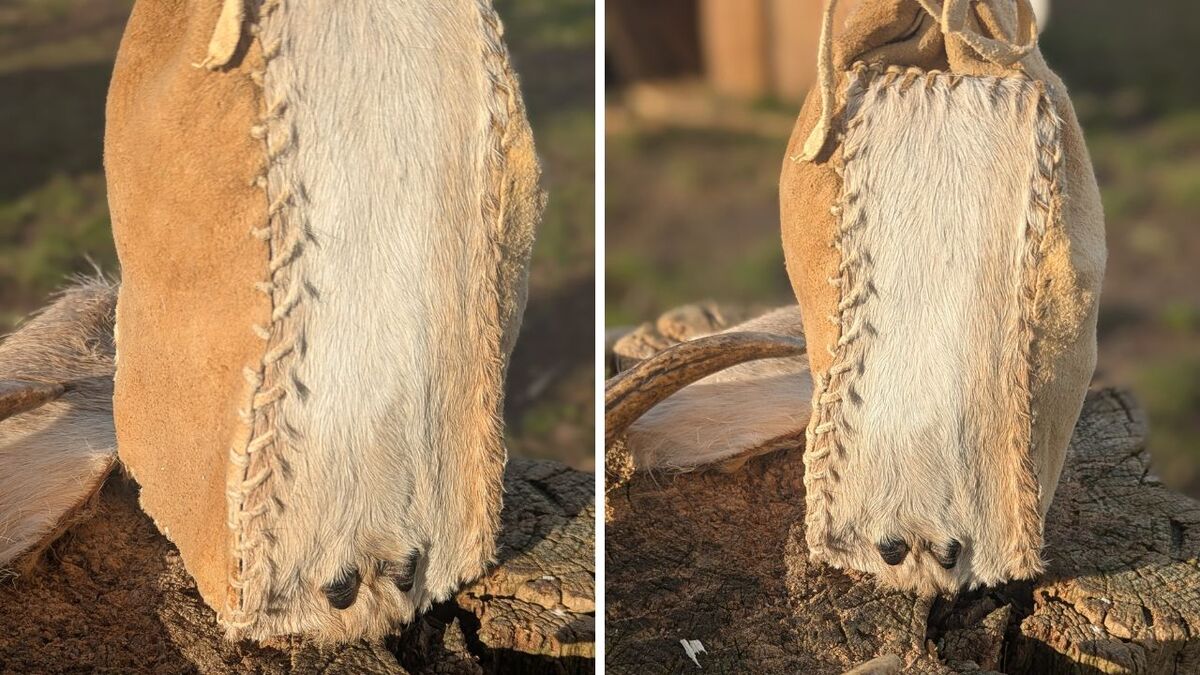
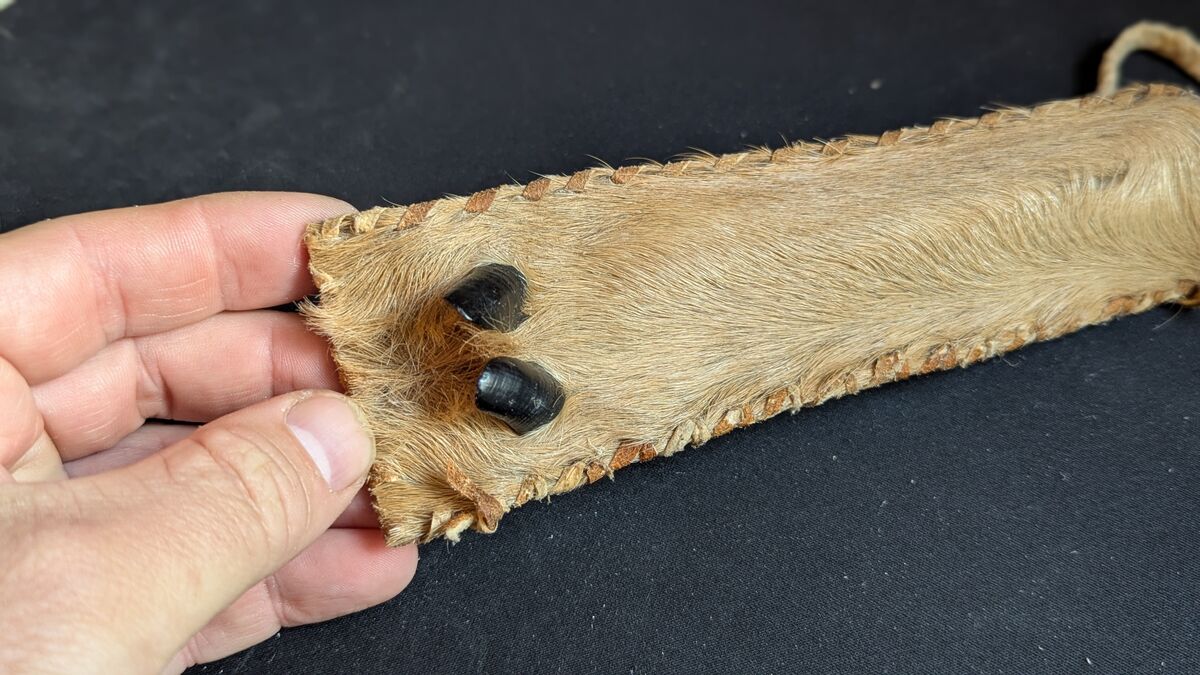
Conclusion: A Cycle of Respect and Abundance
Using a deer holistically is both an art and an attitude. It begins with the grateful acceptance of the food – meat, organs, broth – and continues in the creative and respectful utilization of all other parts.
It is a deep bow to life, an acknowledgment of the abundance that surrounds us, and a connection to the wisdom of our ancestors. Every part, from hair to hoof, has its value and its story.
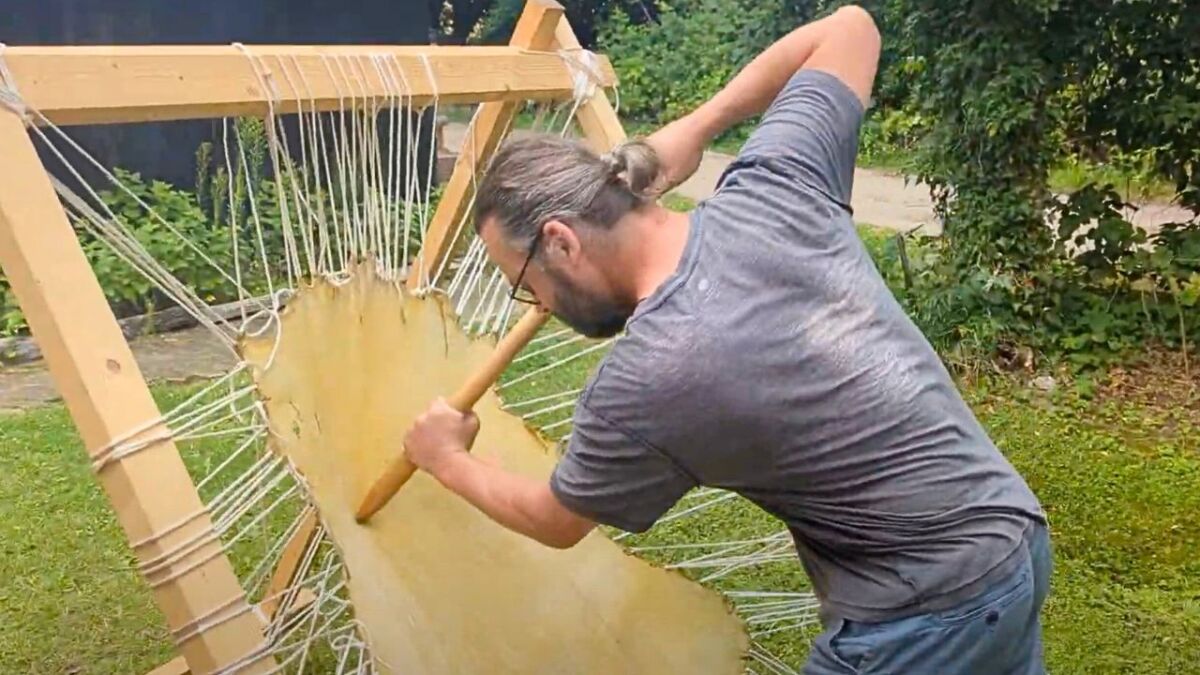
By learning to see and utilize these gifts, we practice true respect and step out of the throwaway mentality, back into a cycle of gratitude and sustainable use.
It requires patience, knowledge, and the willingness to learn from nature itself – a lesson that grounds and enriches us as humans.

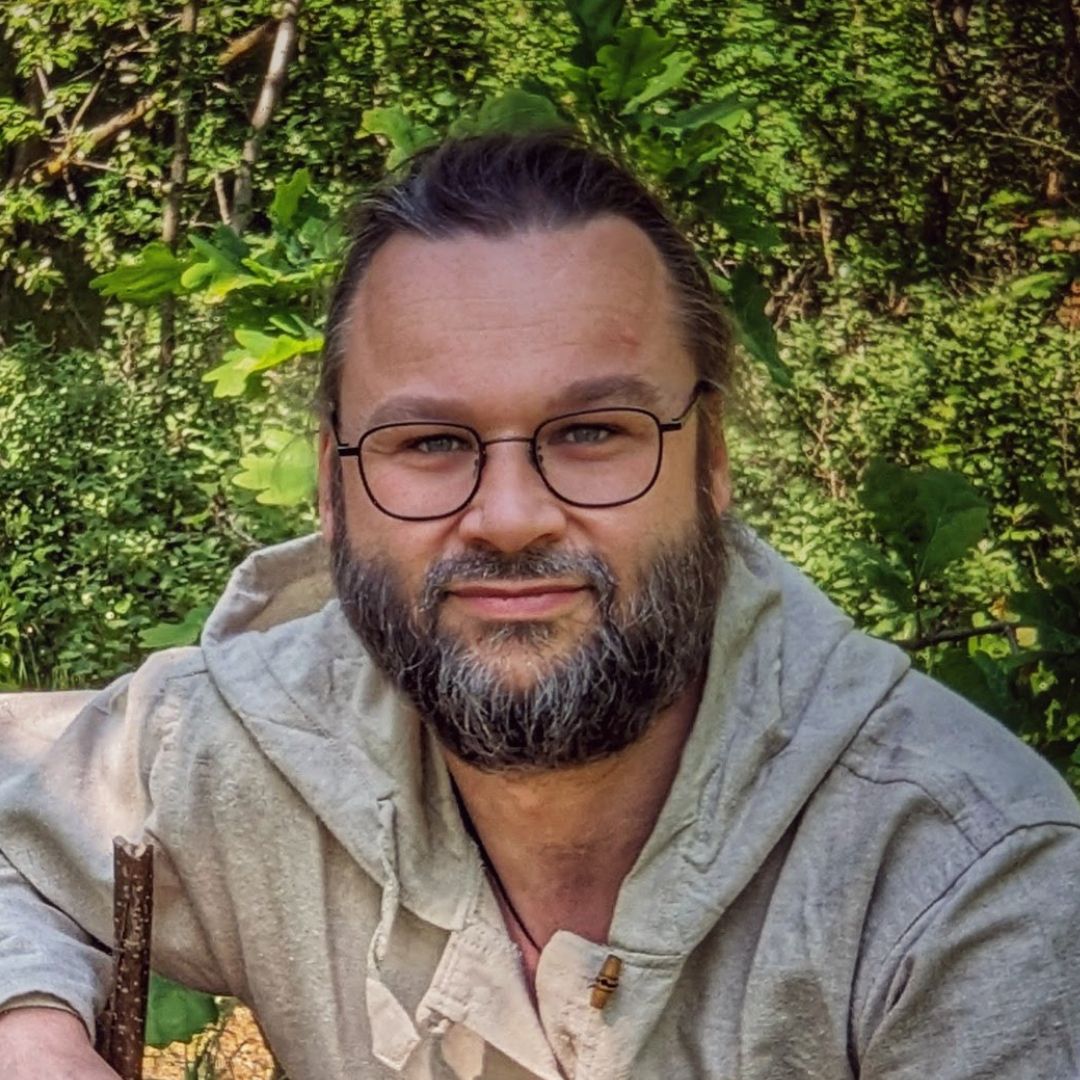
Author of the guide
Martin Gebhardt
Hey, I'm Martin. On my blog, you will learn the basics and numerous details about living in the wild. I think survival, bushcraft and the good life in nature are the keys to happiness. Find me here on Instagram or on YouTube. You can find more about my mission on the About Me page.
Was this guide helpful?
16 people found this guide helpful.
5.00 out of 5 points (16 Ratings)
Comments (0)
This post may contain affiliate links. So if you click on the links and make a purchase, I will receive a small commission at no additional cost to you. Click here, to learn more about it.


